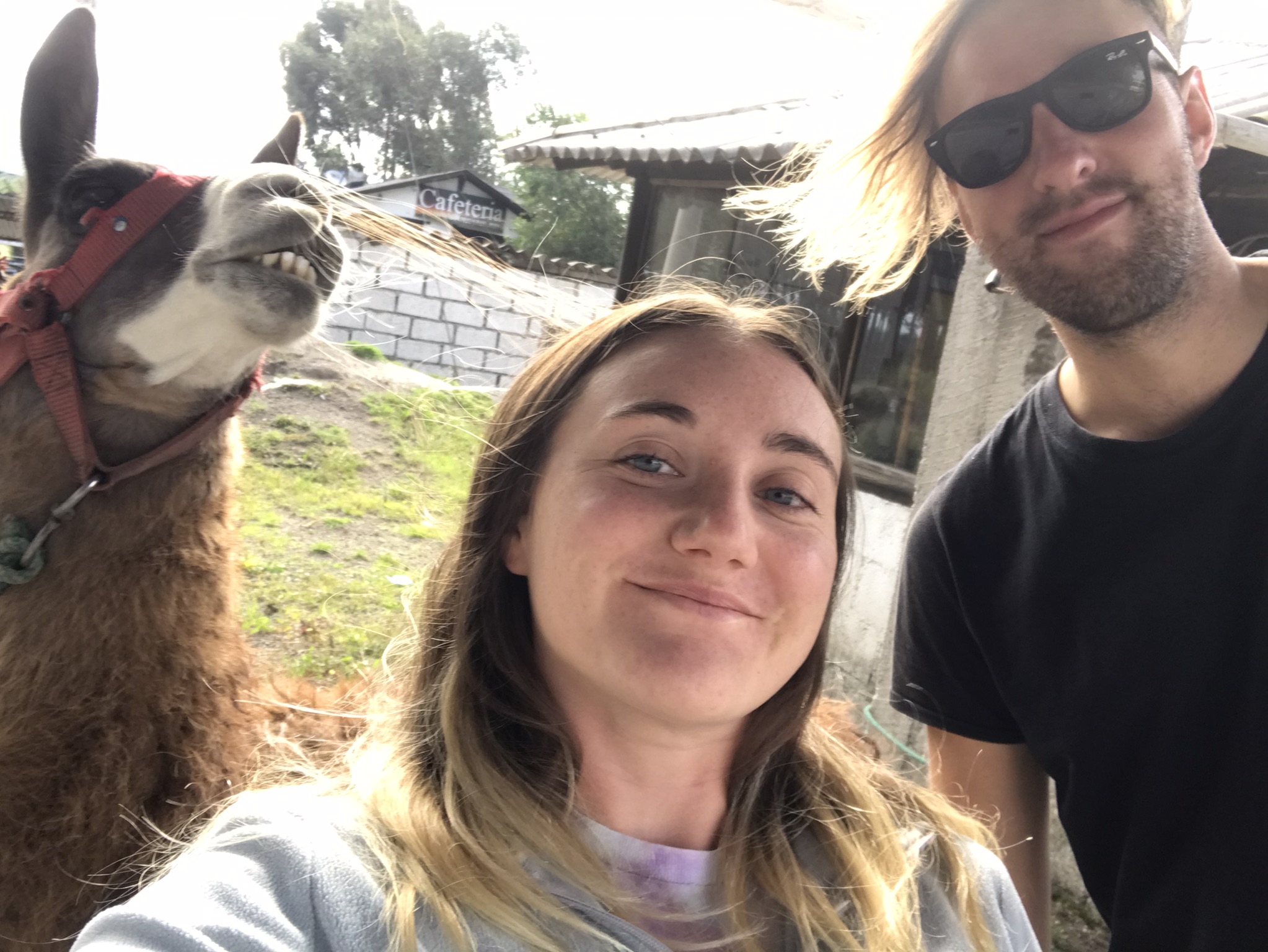Of the 9 countries we visited in South America, Argentina was my favourite. What’s not to love about great wine, excellent steak and tango? I certainly overindulged in all of the above! We found Argentina to be an incredibly varied country with humid jungle terrain in Puerto Iguazu, barren landscapes around Salta, masses of vineyards in Mendoza, snow-capped mountains in Ushuaia and cityscapes in Buenos Aires. Argentina has it all as far as I’m concerned. Check out my Argentina travel experiences below!
Salta, San Miguel de Tucuman, Cordoba, Mendoza, El Chalten, El Calafate, Rio Gallegos, Ushuaia, Buenos Aires, Puerto Iguazu
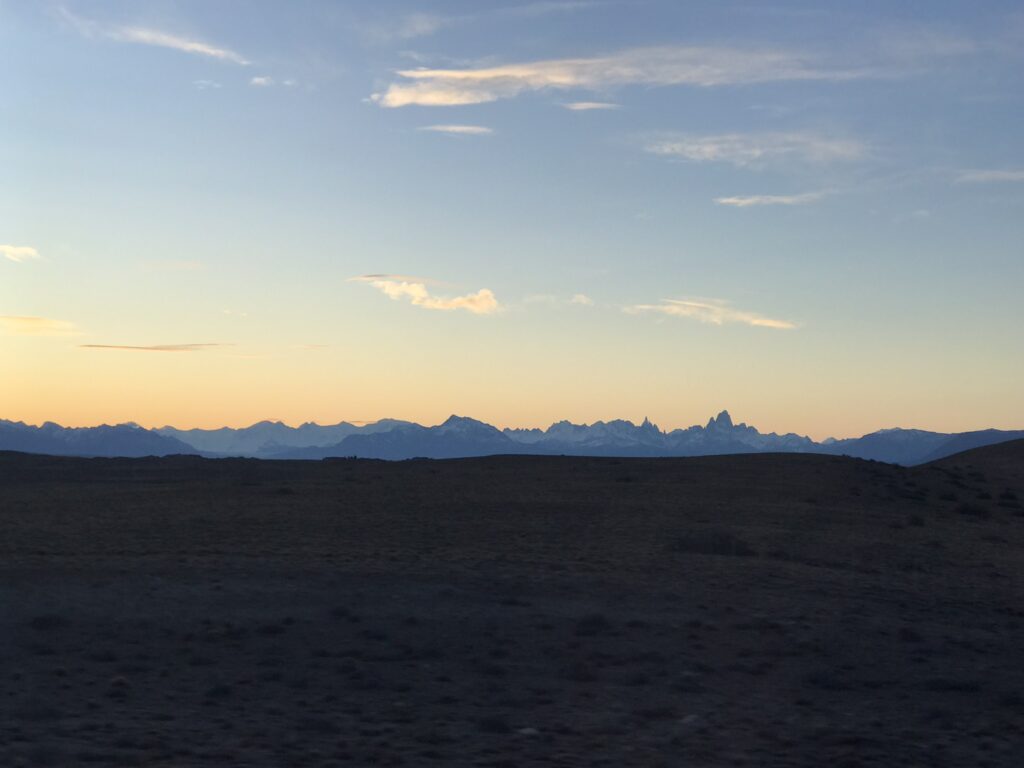
We didn’t have any safety concerns here but as always be vigilant and don’t take risks when it comes to your safety. We did see an older woman have her necklace snatched close to the Pink House in Buenos Aires, which was the only time we personally witnessed a crime in South America.
Northern Argentina
After almost having a heart-attack from the prices in San Pedro de Atacama, we changed our route to head straight into Argentina instead of traveling south through Chile. We did this purely to avoid high Chilean prices, however as it turned out we grew to love northern Argentina and thoroughly enjoyed the detour.
Salta
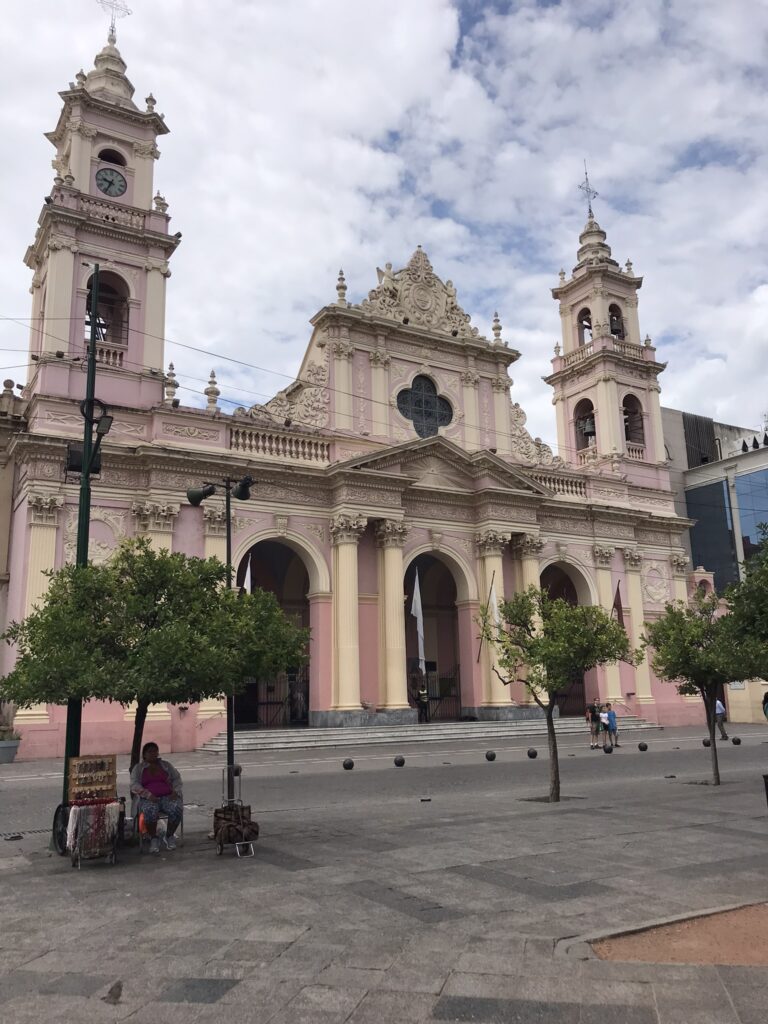
A picturesque city in northern Argentina, a must-visit if passing through. Don’t drink the tap water! I did and had to endure 5 awful days of food-poisoning. Don’t be like me!
Accommodation
After a slight hiccup with our original apartment being double-booked on booking.com we opted for Hotel Pachá Salta.
We arrived at around 8pm at the apartment block that we were originally supposed to be staying at only to be greeted by a confused doorman who, after making some calls, told us that the place had been double-booked. Definitely the worst experience when first arriving in a country at night and after a long cross-border bus ride. The apartment had been non-communicative on Booking.com and what I learned from this was to always message the accommodation before arriving and if they don’t respond before your departure day, cancel! As you can imagine, we weren’t in the best of moods after this, thankfully we stumbled into Hotel Pacha which was close by. This hotel had vacancies at a reasonable price and we were able to pay in cash. I spent many a day bed-bound with food poisoning in Hotel Pacha and, whilst it was budget quality, it was a comfortable prison for those 5 days of hell. I think I even left an indent in the mattress!
Foodie Places
Many travellers obsess with finding the best steak restaurant and eating the best steak in Argentina. We just happened to find 802 Cocina A Las Brasas by chance and I can honestly say that this was the best steak I had in over a month spent traveling in Argentina. Much steak was consumed by ourselves in Argentina but I could never beat my first steak in the country at 802 Cocina A Las Brasas. It was like I was constantly chasing a high that I could never achieve again! This steak (bife de chorizo) was served with incredible chimichurri, chips and fermented pickles. It was also one of the cheapest steaks we had in the country! This thick-cut steak and half a bottle of top Argentinian wine cost around £10 using the blue dollar rate. This restaurant sits on a lively street filled with many bars and other restaurants and is the centre of the night-life scene in Salta.
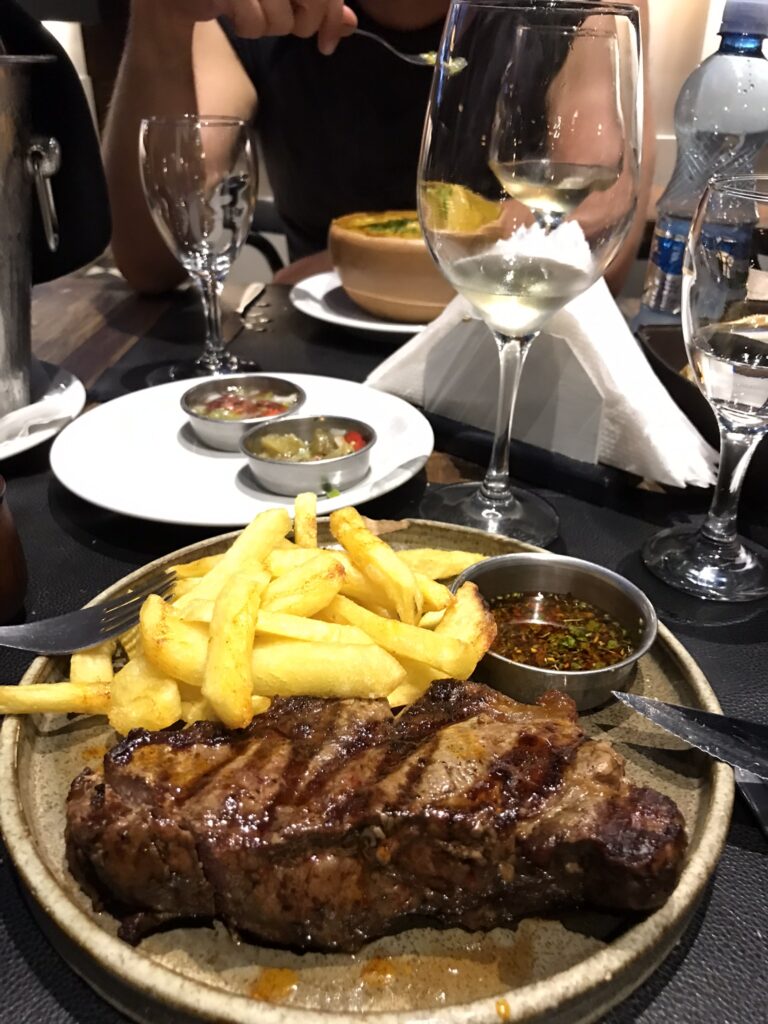
Just look at that steak!
Dm Sandwich – cheap sandwiches, who could ask for more!
El Cuate Taquería – a very authentic Mexican restaurant nestled close to the Alto Noa Shopping centre.
Sandwicheria La Esquina – I think it goes by a different name now, this was the busy takeaway place on the corner. You can either eat in or takeaway, it’s open late and serves up dirty fast food.
Trocadero – modern, quirky cafe in the Selina hostel, serves up the usual backpacker fare of avocado toast and light meals.
Bartom – very varied menu with huge portions.
Activities
Group tour to Jujuy province during Carnaval. This was a crazy experience. We booked a Spanish-language day trip with a local tour company so didn’t really know what was going on a lot of the time, however the guide did her best to make us feel welcome. First we visited the rainbow mountain in Purmamarca, we appreciated this as we never made it to the more famous Rainbow Mountain in Peru. The colours of the mountain were more intense than I thought they would be and the town itself was quaint with an old colonial-style church and plaza. Then we braved the traffic jams to reach Humahuaca, passing small road-side villages along the way where communities gathered together to celebrate carnaval with music, drinking, locals wearing devil masks and spraying each other with fake snow (cans of shaving foam). We took part in the festivities in Humahuaca and by the end of the day I was absolutely covered in white foam, flour and confetti. We had fun spraying each other and the locals with foam, ‘surprise attacks’ and childish retaliations followed!
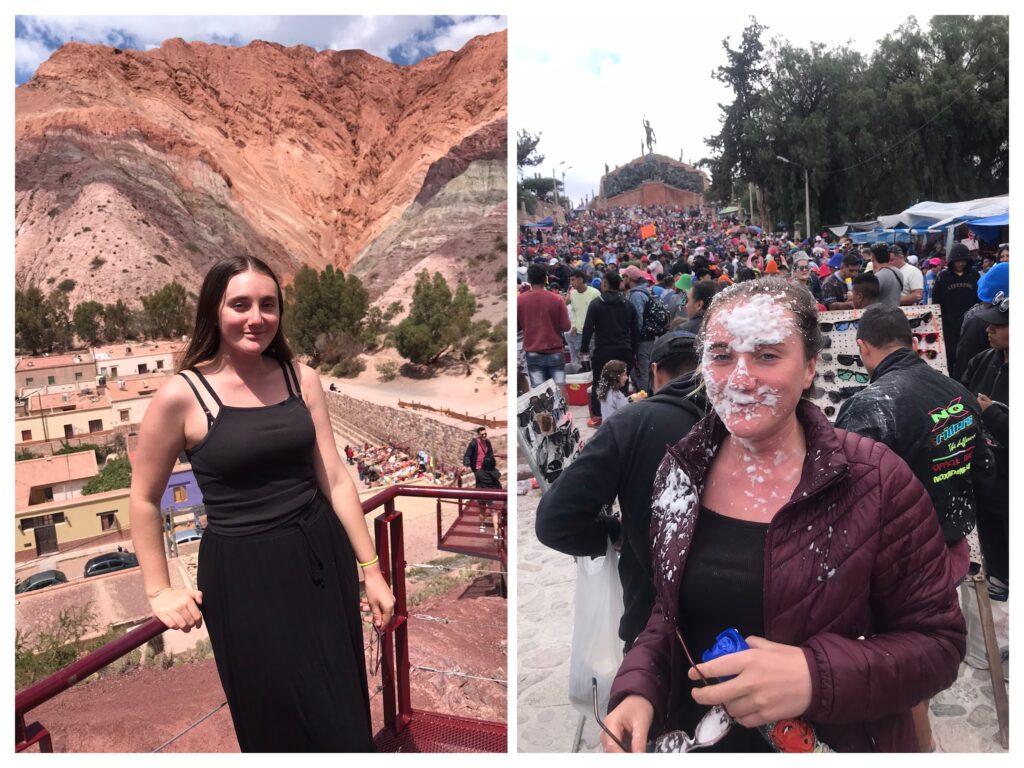
Before and after carnival celebrations in Humahuaca
Self-guided walking tour – we were stood up by the free walking tour guide, a daily free walking tour was advertised online and several people were gathered at the meeting point but no guide showed up. We opted to do it ourselves with GPSmycity, not only was it cheaper but we could take our time at each stop.
Guemes Museum – The museum is dedicated to Guemes, a local general who fought for Argentina’s independence from Spain. There are videos about General Guemes’ life and military career in each room, the videos even have subtitles in English!
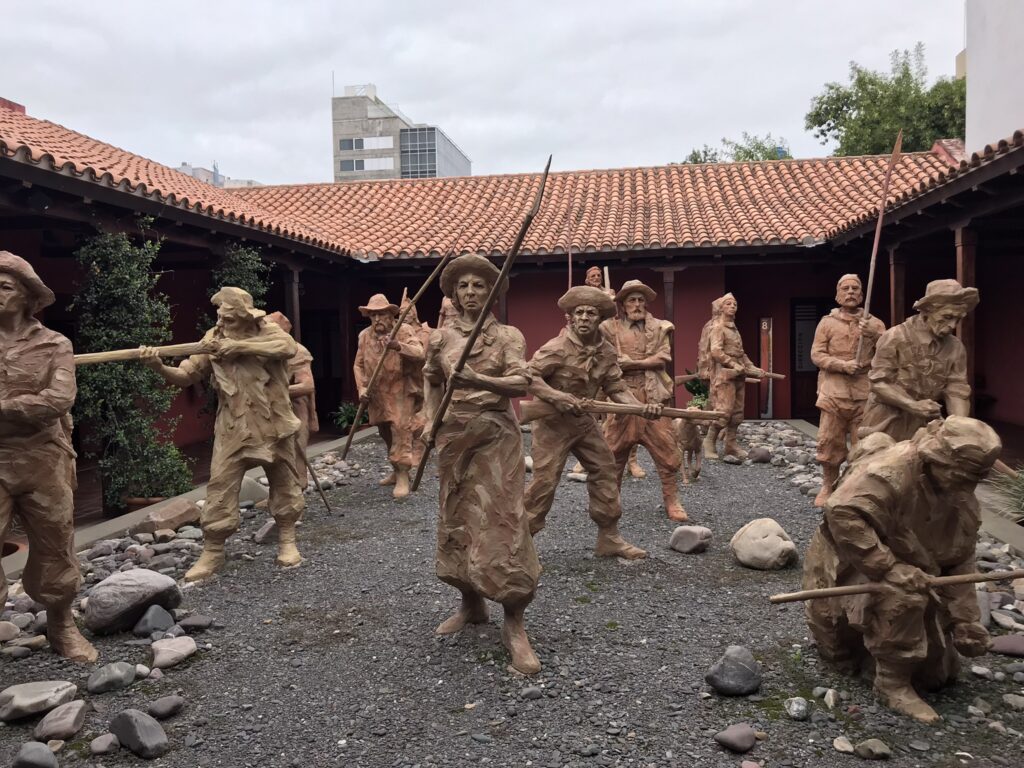
Illustrating the peasant army in the Guemes Museum
Alto Noa shopping mall – we don’t usually go to shopping malls but we needed to stock up on some clothes lost during various laundry runs, there is free wifi here which is a perk.
Boating on the small lake in San Martin Park – a fun, relaxed activity, a perfect way to wile away the time before boarding the bus at the nearby bus terminal.
Teleférico San Bernardo – we took one look at the long queue for the cable car and decided to pass on this activity.
San Miguel de Tucuman
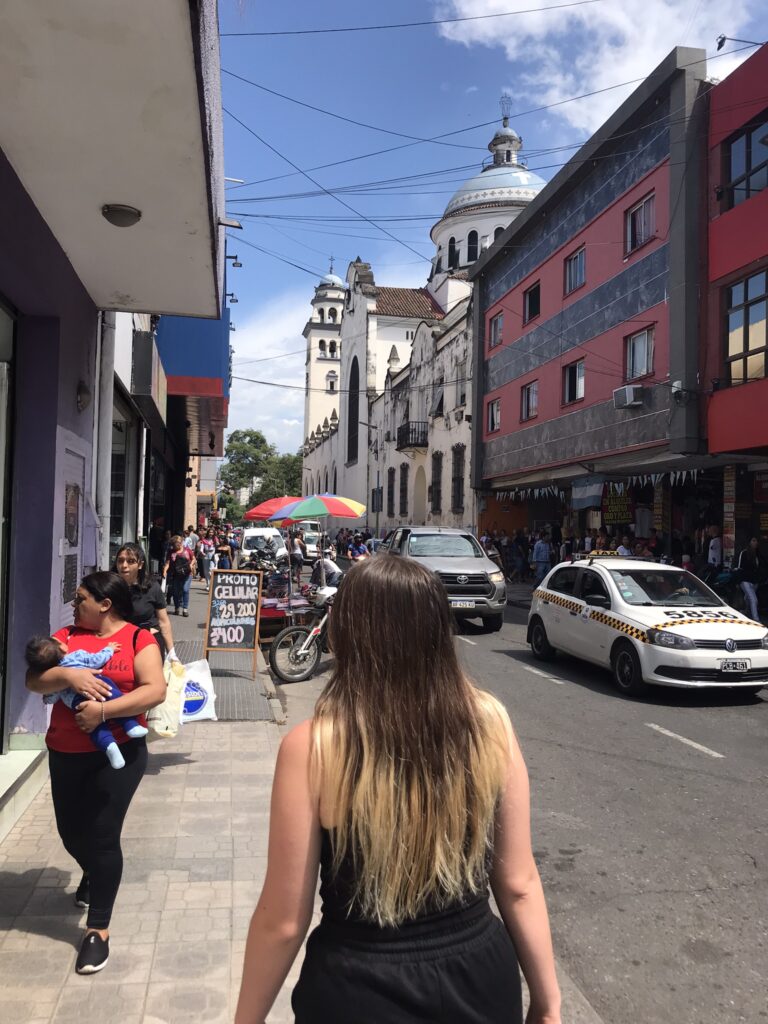
We decided to stay here to break up the long bus journey from Salta to Cordoba, as I was still feeling very sorry for myself after the bout of food-poisoning. Tucuman was an important place in Argentina’s history and independence from Spain and so worth a short visit for history buffs.
Accommodation
Hotel Garden Park – highly recommend! By using the blue dollar we got a really good deal, the breakfast buffet was amazing and the pool and gym were a great addition.
Foodie Places
Il Postino – this restaurant is close to the main square, Plaza Independencia.
Activities
Tucuman Historical House – this was the place where the Argentinians signed their declaration of independence from Spain, a historic building with displays which were only in Spanish sadly. Entrance is free so worth a visit if you have a spare hour in Tucuman.
Cordoba
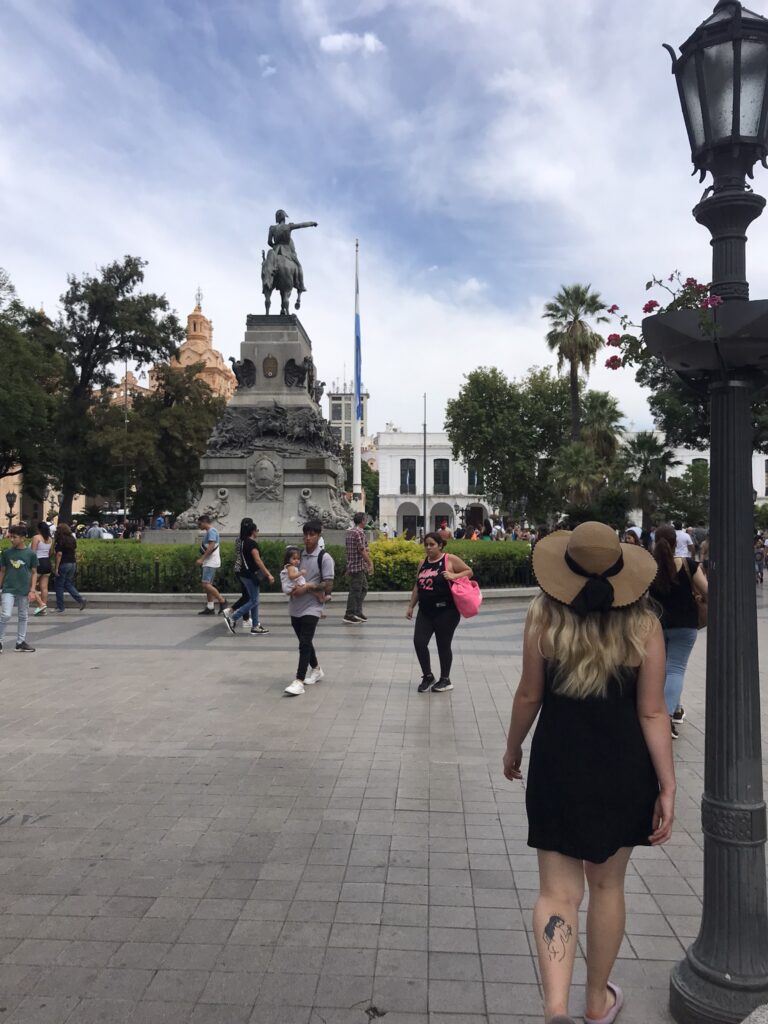
Cordoba is a lively student city with trendy bars and a rambunctious party scene at the weekends. This is the city where we got hooked on Argentinian bakeries, delicious pastries and dulce de leche.
Accommodation
Airbnb close to the Museo de Antropologías, which turned out to be the epicentre of student nightlife
Foodie Places
La Romanina Panaderías – pop in for an empanada, dulce de leche pastry or media lunas, you can’t go wrong here.
Sushi Box – great sushi combos, highly recommend!
Activities
Free walking tour – highly recommend! We took two walking tours covering both the old and the new parts of Cordoba, we found one on Guruwalk and the other was a self-guided tour on GPSmycity.
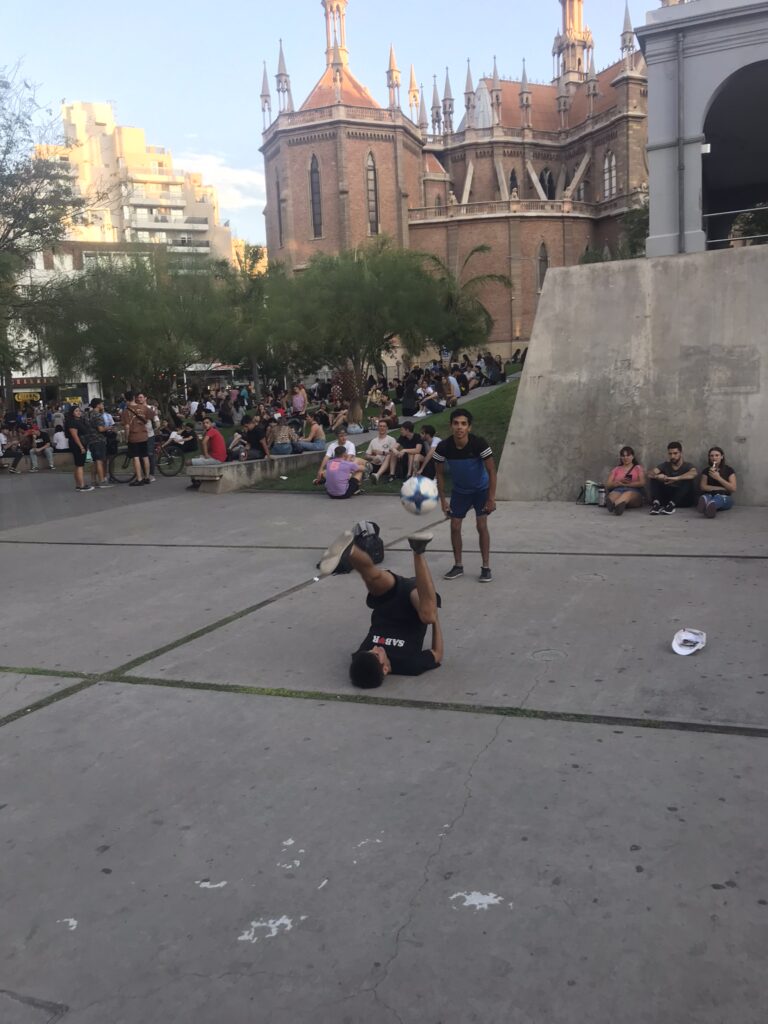
Some very impressive football skills in Cordoba
Mendoza
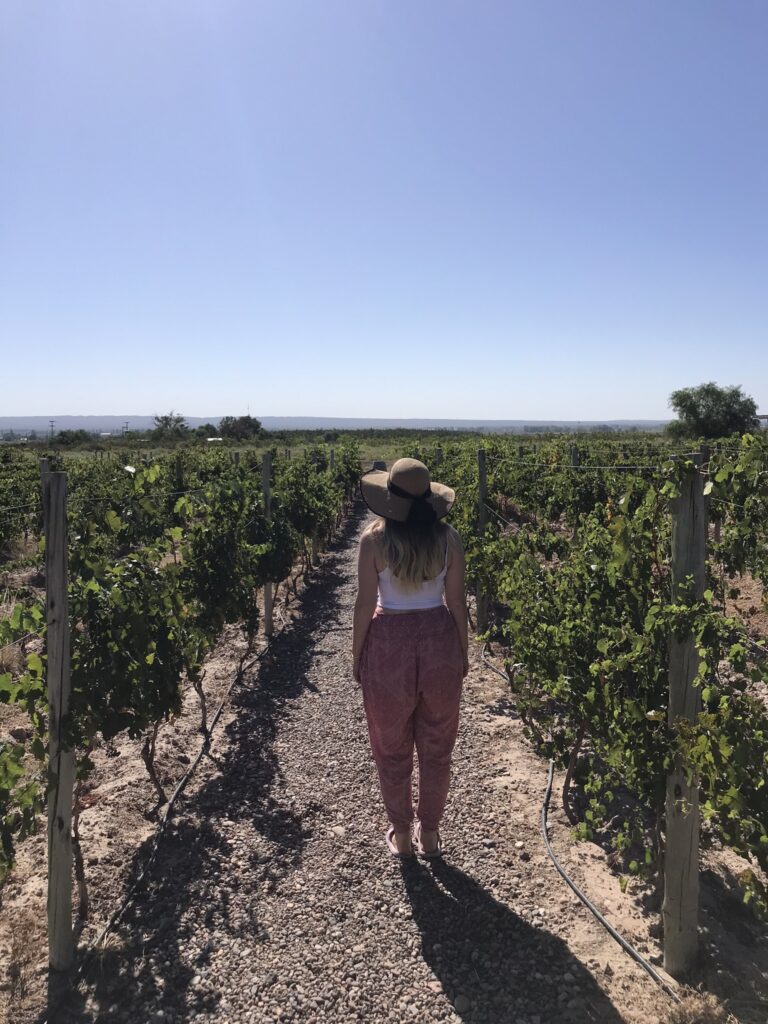
Mendoza is the heart of the Argentine wine region, famous for producing Malbec, it also happens to be situated in a desert! You may ask yourself, how do vineyards thrive in desert conditions? Well, in the city itself there are small aqueducts visible on the streets, made by the Incas, that transport water from the mountains. We duly made the pilgrimage to wine heaven alongside other avid devotees. We found Mendoza more on the expensive side, we put this down to the high influx of European and North American tourists. It’s worth mentioning that we found it difficult to find a winery tour company in Mendoza that would accept Argentinian peso, we think this is due to the deplorable state of the currency and that most companies cater to overseas tourists have dollars.
Accommodation
Airbnb close to the Plaza San Martin – this location was close to the shopping areas in Mendoza.
Foodie Places
Mumbai Masala – we enjoyed a curry here, it has a nice atmosphere with an outside courtyard.
Subway (guilty again!)
Bodega Andeluna – we stopped here on the Valle de Uco wine tour, the food was to die for! The quality of the ingredients really stood out, it was more of a fine-dining experience especially as we were treated to multiple courses. The tranquil views over the vineyard made a perfect setting for lunch and indulging in copious amounts of wine.
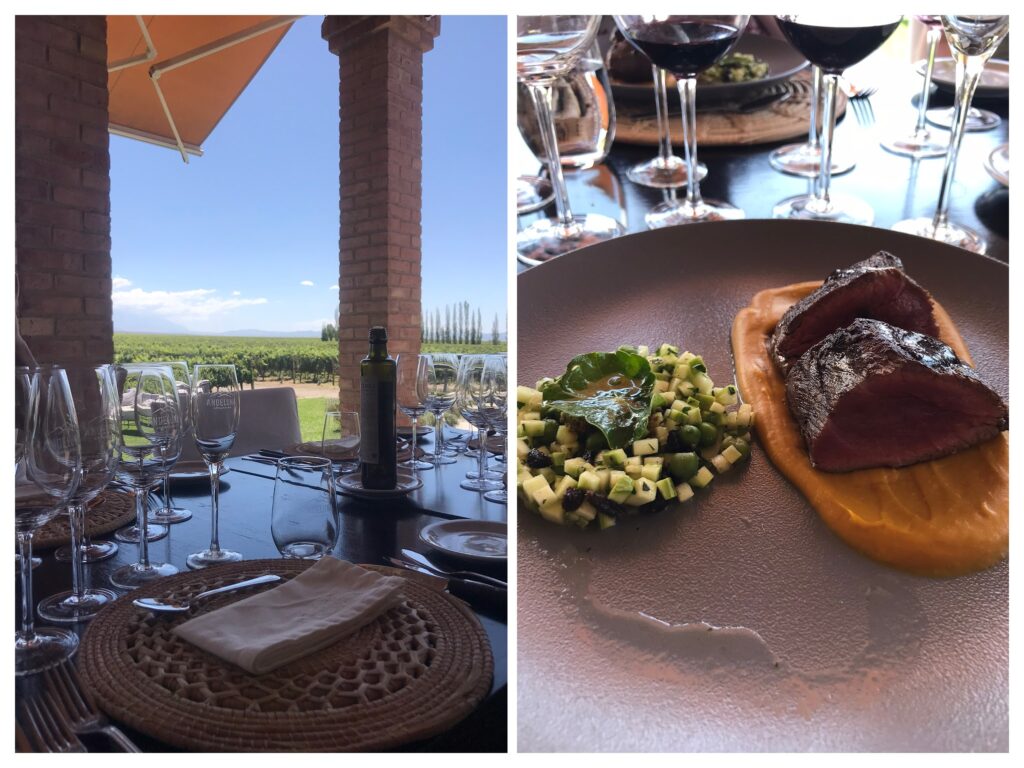
You can’t beat the atmosphere and food at Bodega Andeluna
Activities
Free city walking tour booked through Guruwalk – always a great place to start when visiting a new city.
Indulging in copious amounts of wine naturally.
There are three main wine regions close to Mendoza:
Maipu is the closest to Mendoza, it’s just on the outskirts of the city. You can hire a bike and cycle to various vineyards in Maipu, this is the cheapest option to explore vineyards close by. I believe you don’t need to pre-book to visit some of the vineyards here but it’s worth checking ahead of time. If you decide to cycle, I wouldn’t advise drinking to excess as it can be dangerous cycling when inebriated. Some tourists have to get a taxi back from Maipu with their hired bike in tow after indulging too much.
Pros: it’s close-by, cheap to visit and flexible with timings. Cons: the area is quite industrial (we saw this just driving by) and may not be exactly how you envisioned. Some people (wine snobs) say that Maipu isn’t the best wine region, I wouldn’t give them too much credence though – it’s all about your budget and tastes.
Lujan de Cuyo is slightly further away than Mendoza and Maipu.
Valle de Uco is the furthest wine region from Mendoza, it’s considered (by wine snobs again!) to produce the best top quality wines. There are a range of different wineries here, from small family-run vineyards to mega-vineyards producing and exporting Argentinian wine across the globe.
Trout & Wine, the tour company we used, summed up Valle de Uco much better than I could below:
“Uco is very rural and isolated and some parts are more than two hours drive south of Mendoza city. Traditionally a region of orchards, vineyards did not exist there until 30 years ago. All the wineries are new. It makes for a fabulous day of touring but it is a lot more drive time than drinking time. Saying that if you like imposing mountain views and state-of-the-art wine architecture, Uco could be for you.“
Valle de Uco Wine Tour
We opted to visit Valle de Uco and bypass Lujan de Cuyo and Maipu to see what all the fuss was about. We joined a group tour with Trout & Wine, the tour is pricey at $160 per person but included a visit to 3 wineries with a 5 course tasting menu paired with ‘premium’ wines. First we headed to Familia Blanco, this winery is a small, modern, family winery. We thoroughly enjoyed tasting wines in their picturesque vineyard. We continued to Bodega Salentein, which is an ultra-modern winery famous for its cathedral-like architecture and rich, complex malbec. Here we took a tour of their impressive subterranean barrel room followed by a wine tasting in an underground room tastefully decorated with wine bottles. It was interesting seeing the difference between a small winery and a more vast operation at Salentein. Later in our time in Argentina we happened across a bottle of Salentein wine in El Chalten and it only cost £3 (with blue dollar rate).
Next we stopped for lunch at Bodega Andeluna, where we sampled an exquisite 5-course lunch paired with 5 premium wines. The food was amazing and the dining experience was unbeatable, we were seated outside on the terrace with views over the vineyard.
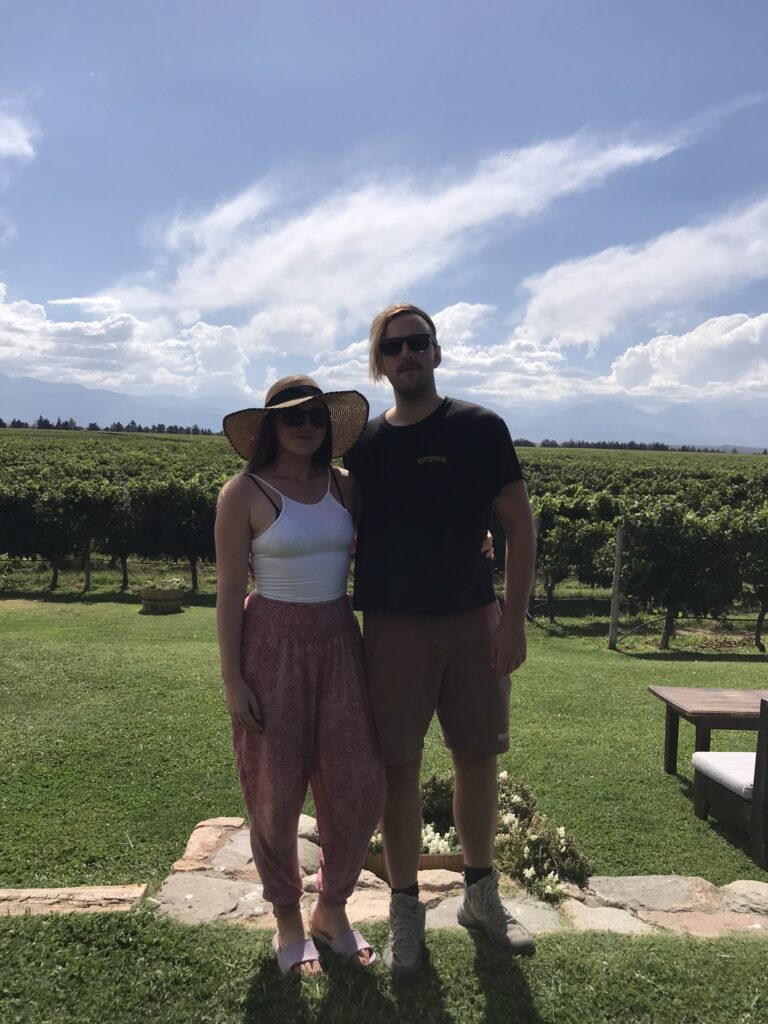
Southern Argentina
After leaving Mendoza we headed over the mountains back into Chile. The bus journey from Mendoza across the mountain range to Chile is considered one of the most scenic bus journeys in South America, I spent most of the journey sleeping but Dan can confirm the views were spectacular!
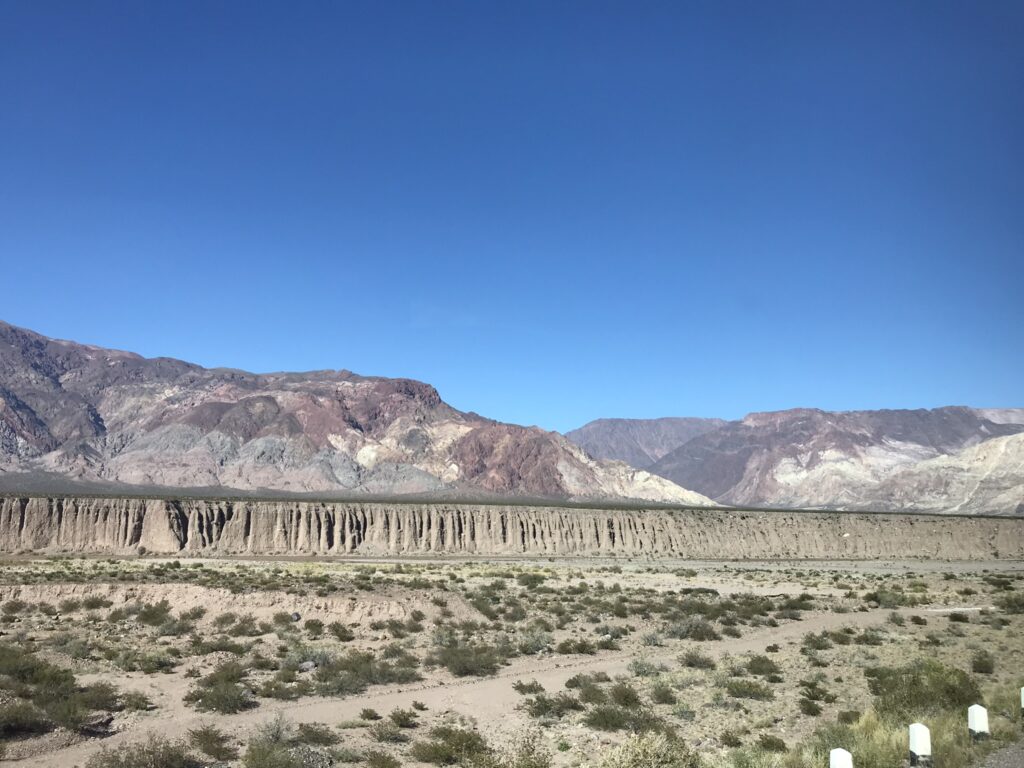
Views from the bus near the Chilean border
We then returned to Argentina a few weeks later in Patagonia, getting the bus back into Argentina at El Calafate after first exploring Chilean Patagonia. By bus it is also possible to head south from Mendoza to Patagoina by going via Bariloche and Esquel, although this means some very long bus journeys through the Patagonian wilderness. It is also possible to fly into El Calafate from many cities in Argentina.
El Chalten
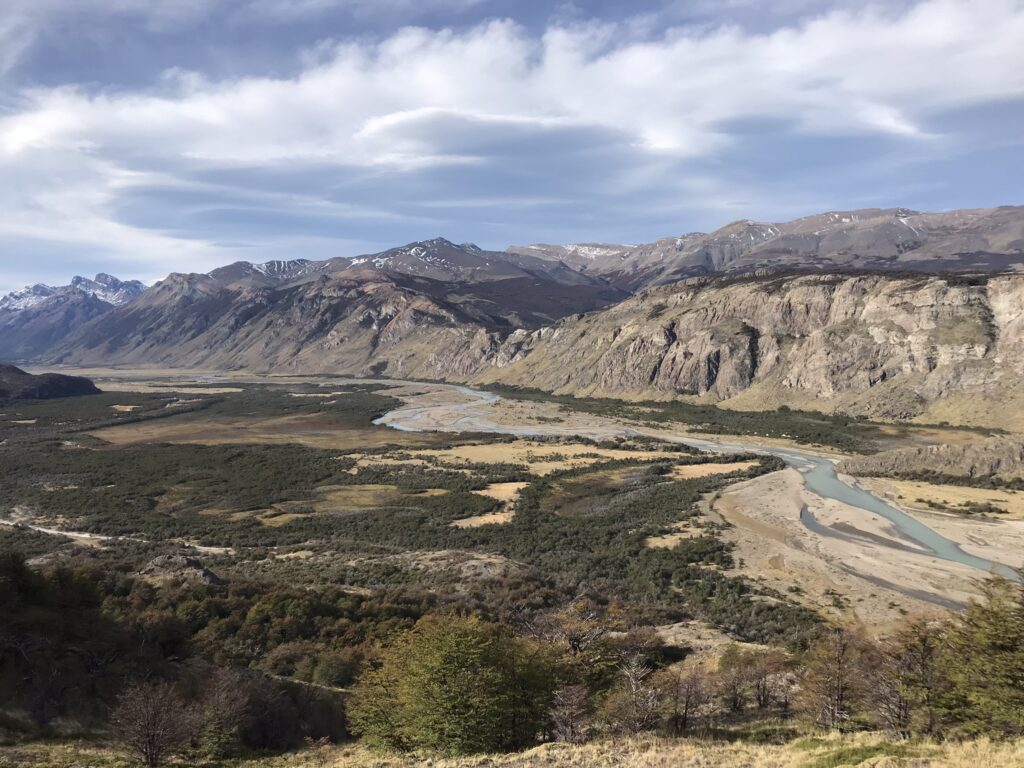
A small yet touristy hiking town nestled in the mountains close to El Calafate. We got the bus here from Calafate but it is possible to get direct buses from Esquel in the north too. The vast majority of visitors come here to hike the two main circular trails: Laguna Torre and Fitzroy.
Laguna Torre is the less challenging of the two walks, the highlight of the trek is marvelling at Laguna Torre itself. The path is well-marked and you’ll find many hikers along the route. It’s also possible to camp here, we walked through a campsite on our way back.
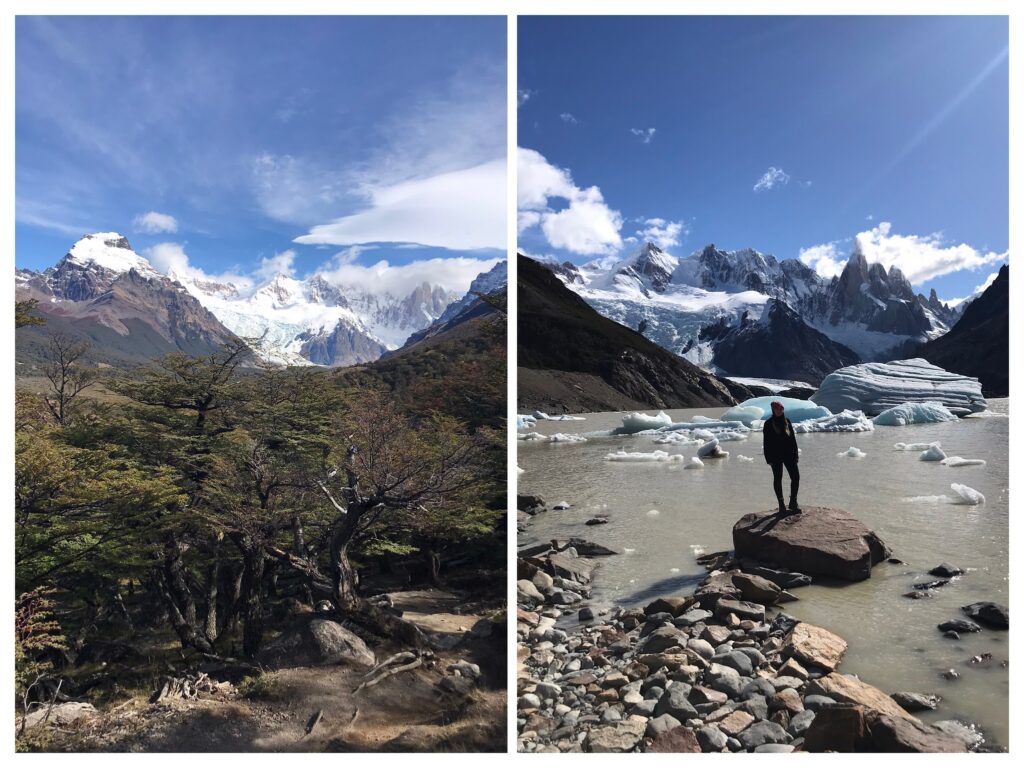
Laguna Torre trek
Fitzroy is the longer and more challenging trek of the two. I highly recommend bringing walking poles, you can rent these in El Chalten or just pick up a sturdy stick on the route. You need to start early to complete the hike before dark, we started the hike at 7am as other travellers had given us a heads up. Be prepared for a 400m uphill scramble (and I mean scramble! There’s even a signpost warning hikers about the dangers) to reach the main viewpoint over the lagoon and Mount Fitzroy. The slope is steep, shale at points and with slippery rocks, not ideal for wet weather. Make sure you have appropriate footwear and at least one walking pole. My makeshift stick made the walk easier than it would have been otherwise. It’s another final uphill slog to reach the end of the trek with the best view. It’s possible to camp in the woods just before the killer climb, however the toilet facilities are very basic (i.e. a shovel and wooden shack with a hole). I believe this campsite is free so it’s a good place to stay if you want to avoid the astronomical price of accommodation in El Chalten.
Pray that it’s a clear day.
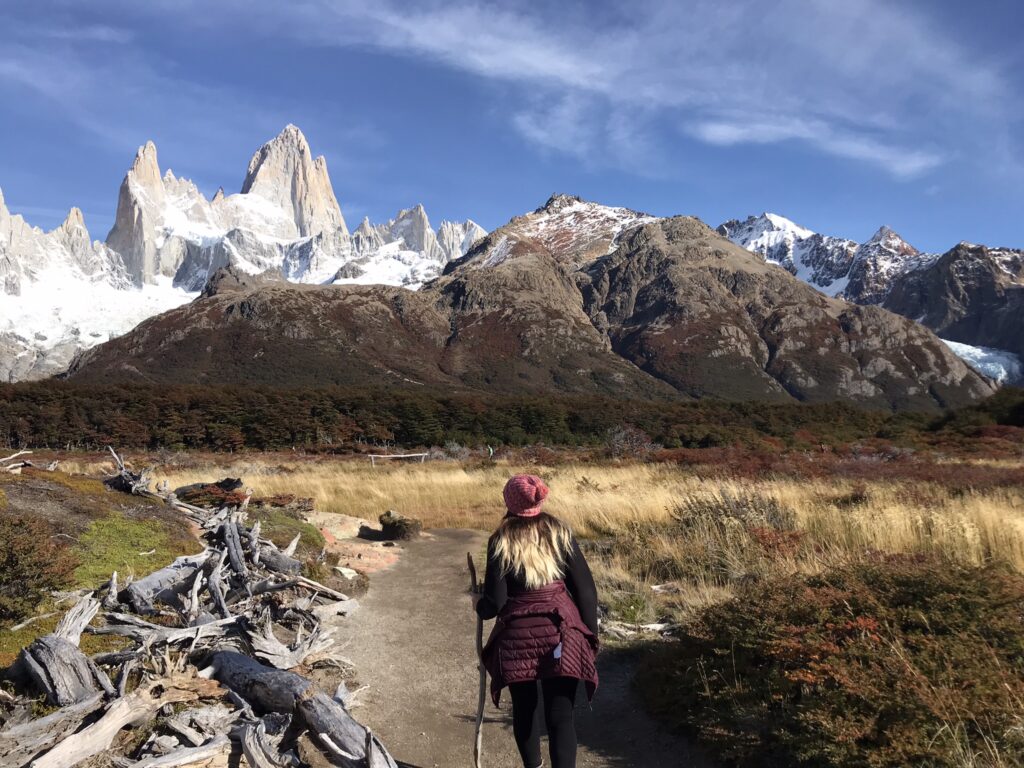
The fantastic Mount Fitzroy
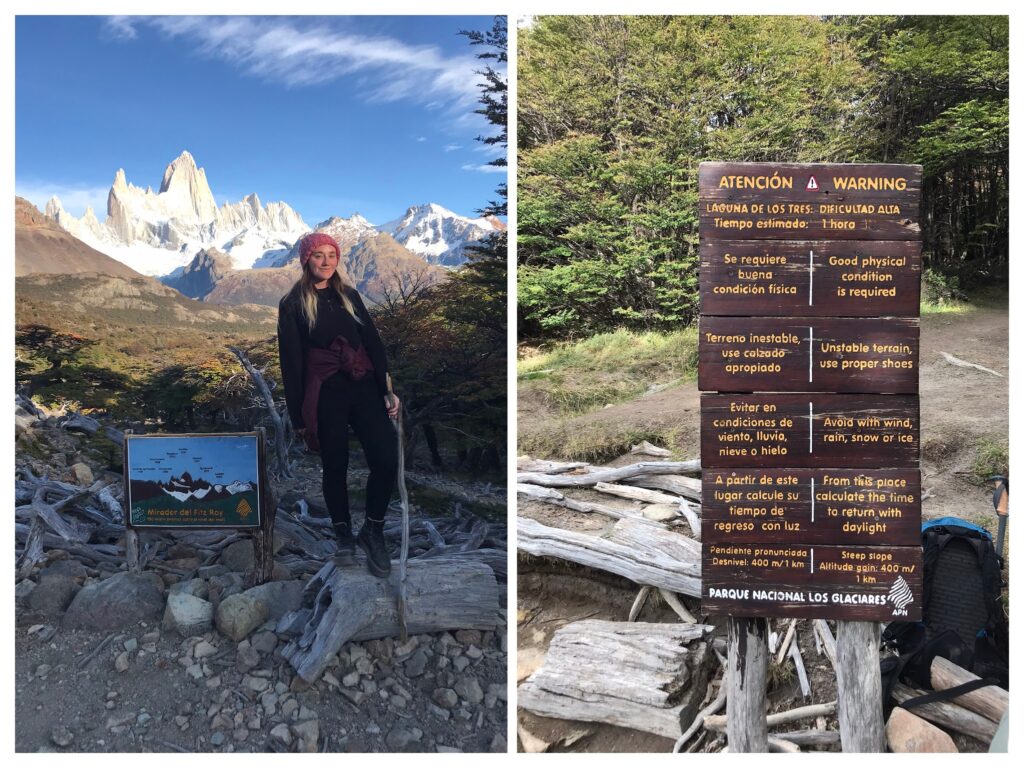
‘Steep slope’ is an understatement
Accommodation
In the interests of saving money we opted for an Airbnb apartment along the main street, this was perfect for us as it was located close to restaurants and bakeries in the town centre. Unlike in other parts of Argentina travel and accommodation is somewhat expensive in Chalten as it is a popular tourist town and usually books up fast.
Foodie Places
We mainly ate home-cooked meals here to save money. There are loads of bakeries on the main street, we picked up empanadas before setting out on the two treks and they were a great lunch, you can also buy sandwiches too.
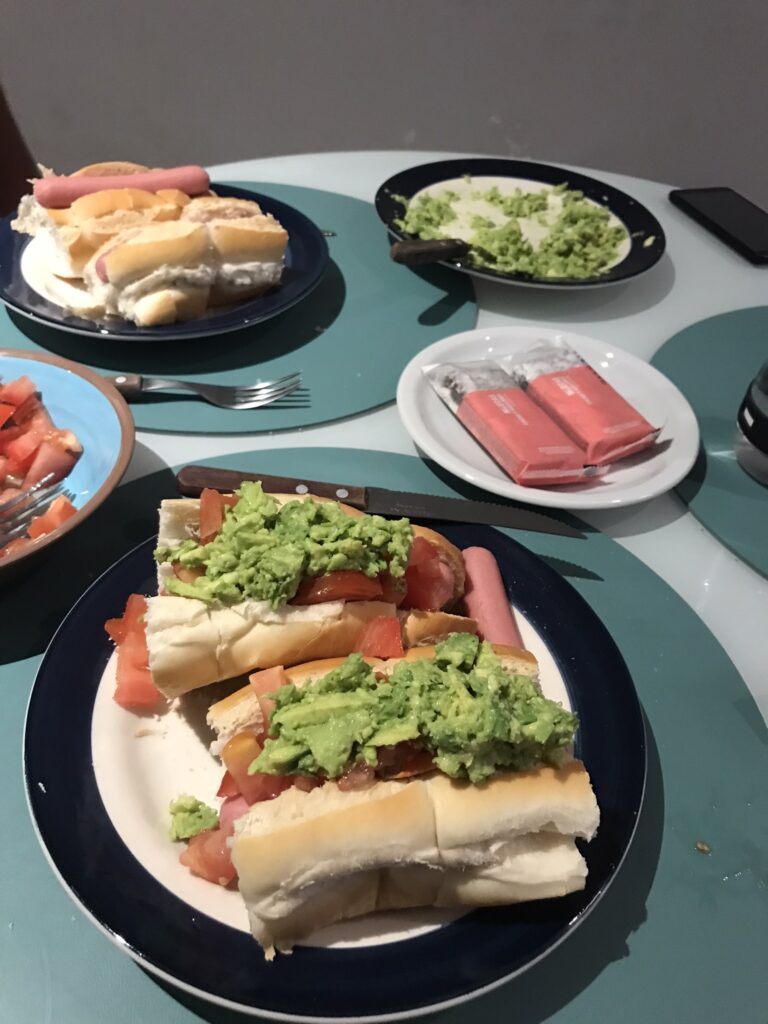
An example of our daily home-cooked fare: Chilean-style completos for dinner
Activities
Trekking, trekking and more trekking – Laguna Torre and Fitzroy trek as mentioned above
Horse-riding at Bonanza ranch with Patagonian dinner – we booked this trip at the Bonanza Adventure office on the main street, we rode through the ranch admiring the mountain views and arrived at the ranch-style restaurant at sunset. It was magnificent to watch the sunset whilst sipping Argentinian wine inside the warm restaurant. The food was spectacular, especially the Patagonian lamb cooked whole over the fire and the black sausage (morcilla) with fried egg in a skillet, the lamb was so tender and the portions sizes were impressive. All in all a very positive experience and something non-walking related to break up the treks.
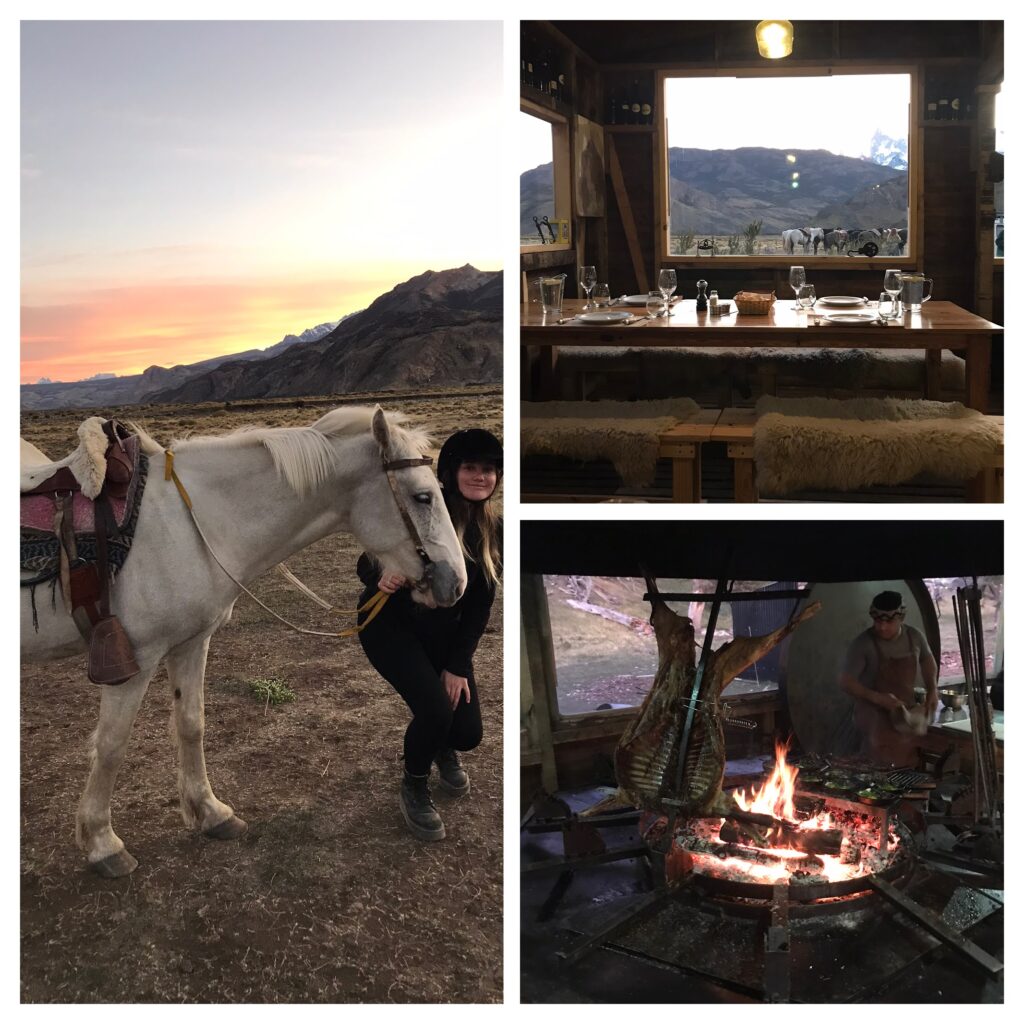
El Calafate
A small tourist-oriented town which is the gateway to the Perito Moreno Glacier. There are a few bars and restaurants here mainly catering to tourists, apart from that we found there was not too much to see or do in the town itself.
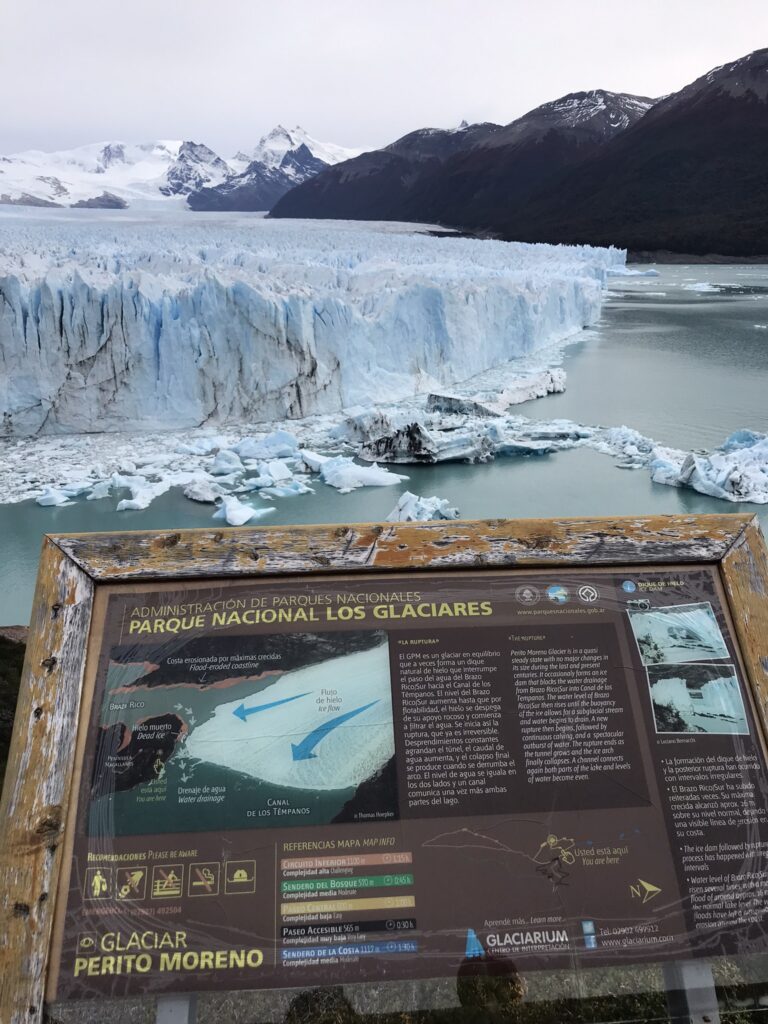
Accommodation
Folk Suites – good value for money, has a shared kitchen and offers free breakfast.
Foodie Places
Don Luis – a bakery with a varied selection of cakes, sandwiches and empanadas, great place to grab your packed lunch if heading on a tour.
Mako Premium Bar – touristy bar and restaurant, I had a nice lamb burger here.
Activities
Perito Moreno Glacier -we opted to join a group tour which included a boat trip and entrance to the walking trails. There are pros and cons to this, the main con being that we had to almost elbow people out of the way on the boat trip to get a photo with the glacier. The boat was very crowded and everyone wanted to get the best angle for a photo but then wouldn’t move or let anybody else take their space once they were finished. This really annoyed me, maybe I was being too polite whilst silently fuming at other people’s rudeness! It wasn’t the serene and peaceful boat trip I’d expected. The boat trip though did at least provide a unique perspective of the glacier from the water.
We were then taken to the glacier viewpoint which consists of a number of walking trails with viewing platforms. I preferred the walking trails as they were less crowded, you could sit and admire the glacier without someone ruining the view. We picked a quiet spot and ate our lunch there, the trails are colour-coded and easy to follow. Keep an eye out for falling ice from the glacier and listen to unforgettable creaking sounds when the ice falls.
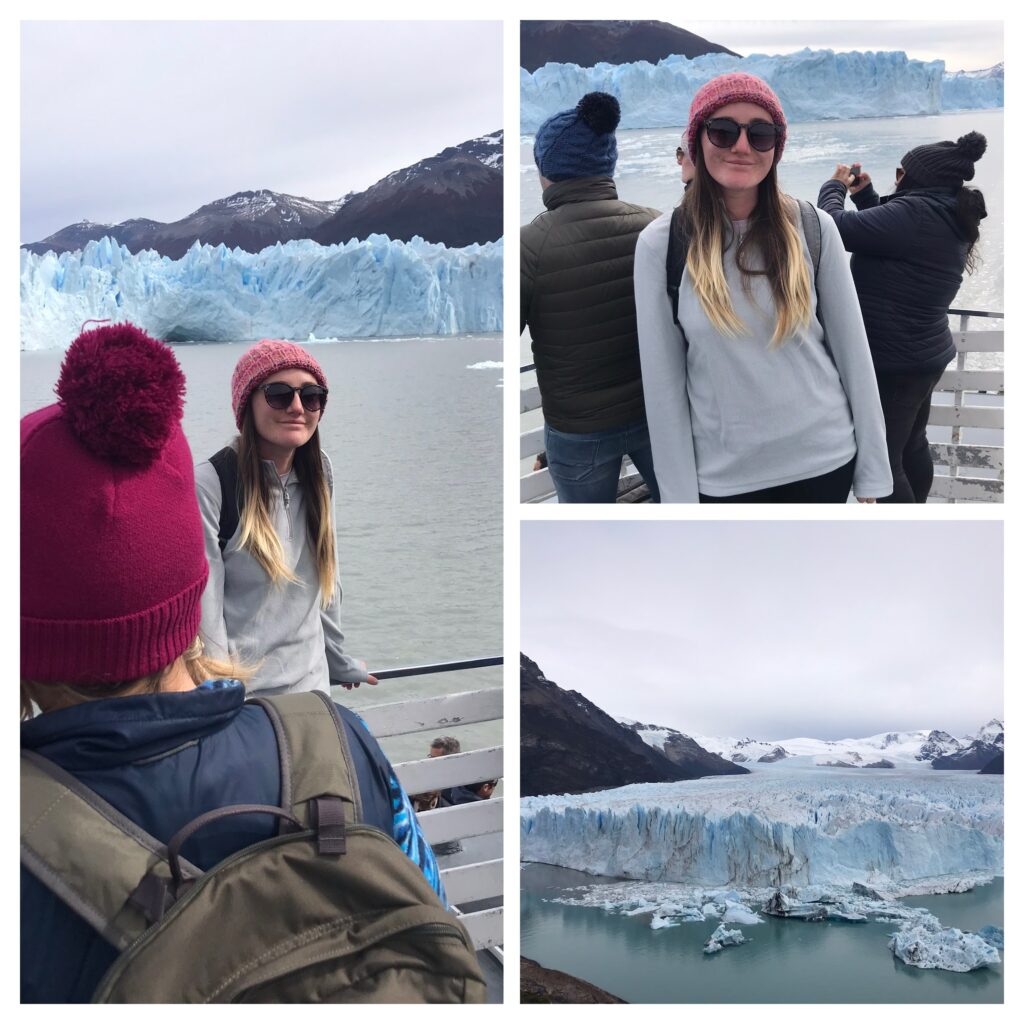
An accurate depiction of our experience on the boat trip to Perito Moreno
Ice-walking tours are also available which involve walking on top of the glacier, we decided against the ice-walk as it was out of our budget however we saw others walking on the glacier and were envious. It’s not everyday that you get to walk across a glacier!
Rio Gallegos
We stopped in Rio Gallegos to break up the bus journey from El Calafate to Ushuaia. All buses from Calafate to Ushuaia need to change at Rio Gallegos, it was possible to get an extremely early bus from Calafate and complete the journey in one day but we decided to go at a more leisurely pace, stop over in Rio Gallegos and take an evening to relax. This turned out to be a good move as we were able to stock up on Argentine peso at the local Western Union.
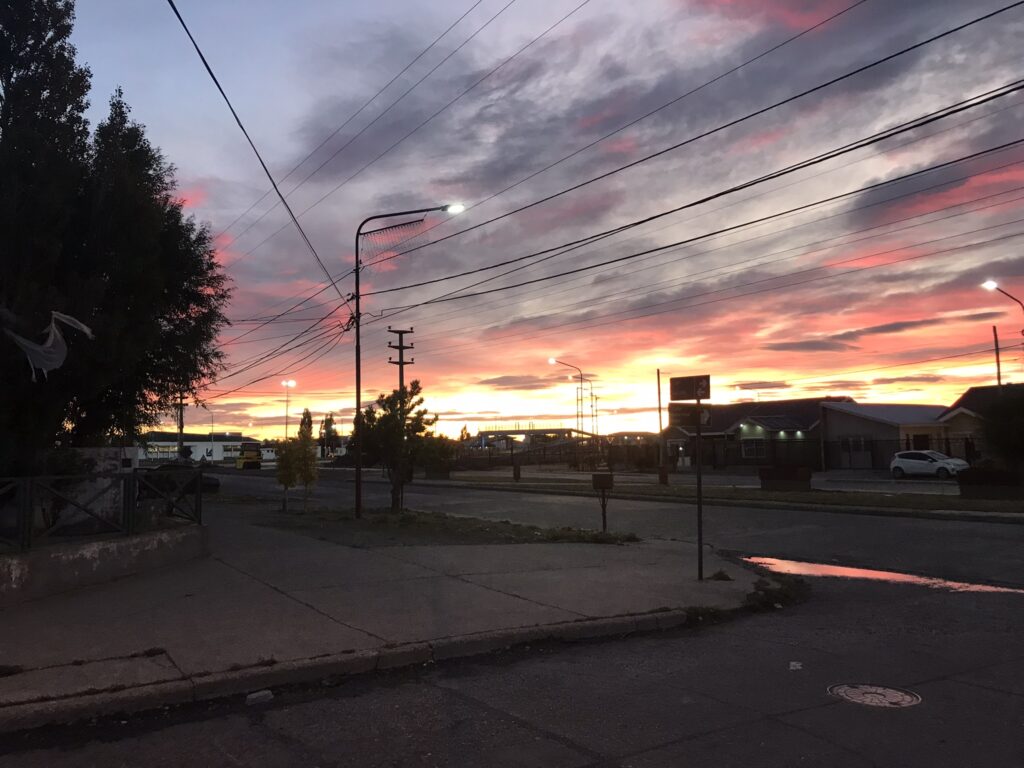
Sunset in Rio Gallegos – not a lot happening here
Accommodation
Airbnb close to the bus station
Activities
We walked around the city. There isn’t too much to see in Rio Gallegos, we took a walk along the windy waterfront area and that was about it. We found Rio Gallegos was not the most welcoming place, most houses seemed to have angry dogs in the yard which barked loudly as we were passing. Maybe they just aren’t so used to visitors.
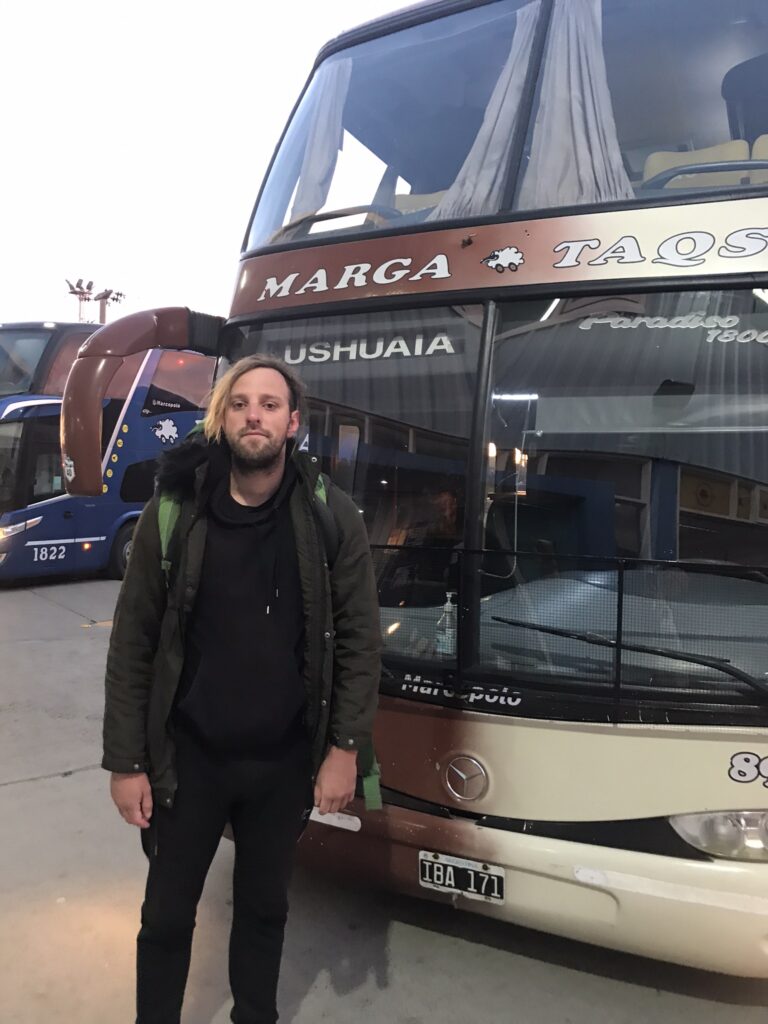
A rare bus to Ushuaia
Rio Gallegos is the only place in Argentina from where you can get direct buses to Ushuaia. This is an unusual bus journey as it crosses through a very short stretch of Chile, you need to pass through Chilean immigration twice and get two pointless passport stamps. We had to queue up the first time we passed through immigration, while the second time when ‘returning’ to Argentina the bus conductor just took our all of passports in to be stamped. This bus journey also crosses the Magellan Strait, the bus boards a vehicle ferry and you can get out and walk around while on the ferry, which was a nice way to break up the journey.
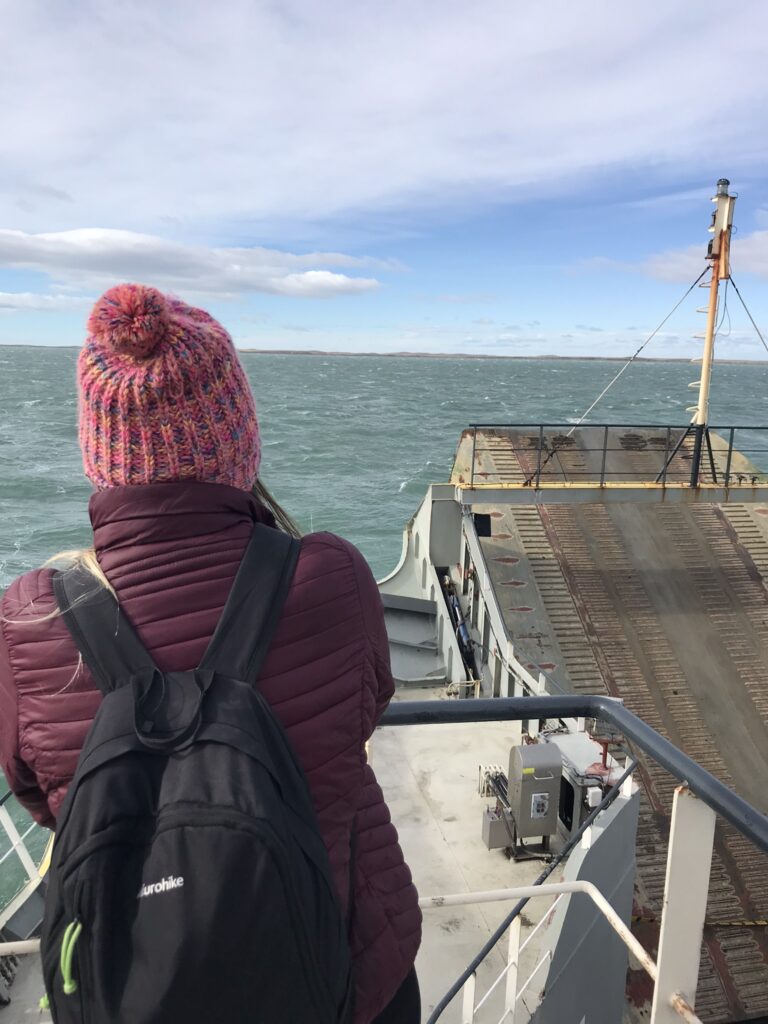
On the boat to the Tierra del Fuego
Ushuaia
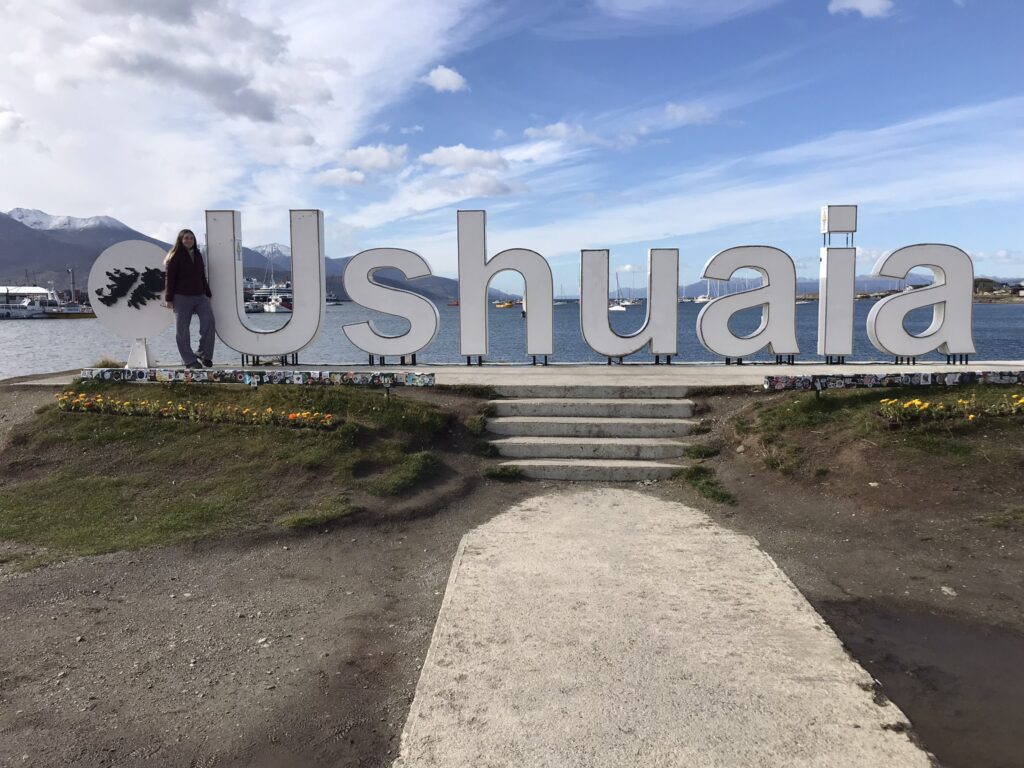
The end of the world! But not really, the Chilean city Puerto Williams is actually further south than Ushuaia. We visited at the very end of the Patagonian summer season in late March, we noticed that some tour offices had already closed and things were beginning to wind down around that time and we could almost feel the weather changing from summer to winter. We were treated to a fresh layer of snow one morning which made the Tierra del Fuego park look absolutely stunning.
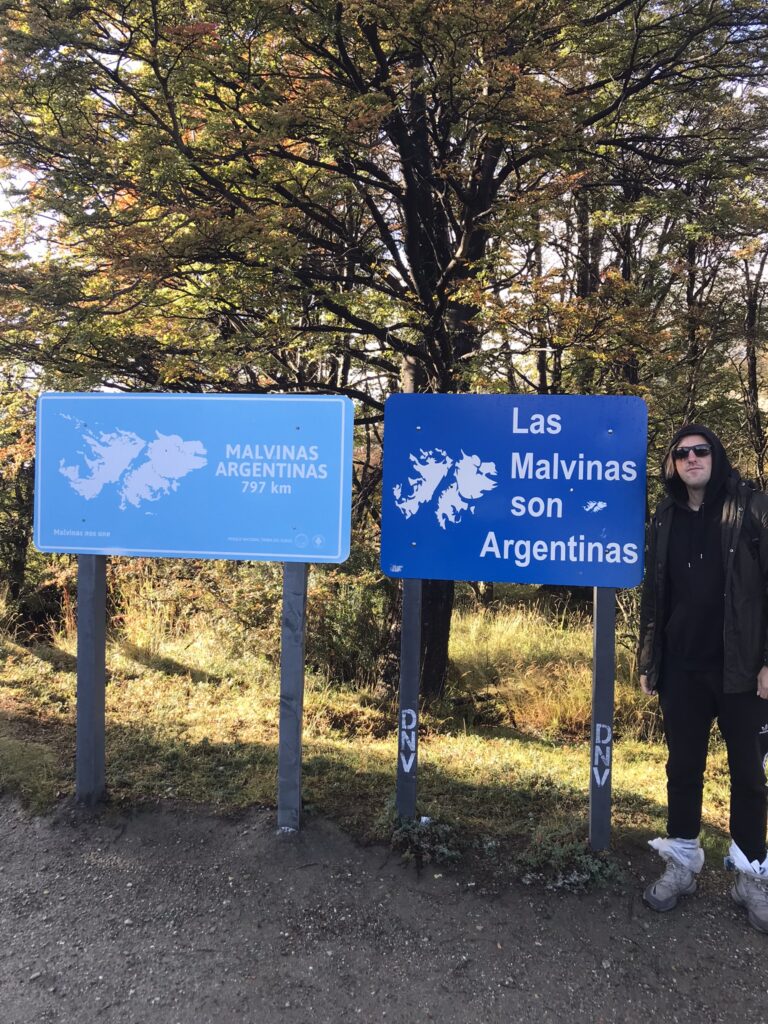
These signs are everywhere…
‘Las Malvinas son Argentinas’ – everywhere in Ushuaia you will find patriotic, nationalist messages about the Falkland Islands belonging to Argentina. This is because Ushuaia is the capital of the Argentinian state which they claim includes the Falklands Islands. There are also many monuments to fallen soldiers of the Falklands War in Ushuaia. According to informal chats with Argentinians, I learned that school children are taught that the Malvinas belong to Argentina as fact, they also sing a Malvinas anthem alongside the Argentinian national anthem in schools (even though this Malvinas national anthem is in Spanish while the official language of the islands is English!). The Falklands War is still very fresh for Argentinians and still a current issue. I’m not entirely sure why the signs state so assertively that the Falklands belong to Argentina, maybe because it’s a tourist and cruise hotspot.
Accommodation
Happy Guest Apart 50 – lovely apartment with all the modern appliances you could possibly want including toastie maker and mate set, the apartment was a little out of town but we didn’t mind the walk, plus it was close to a Carrefour with Western Union.
Foodie Places
Yagan Resto – the Patagonian lamb stew and ‘crabby patty’ were to die for! I really recommend this restaurant, even though prices are high in Ushuaia we couldn’t resist going there twice.
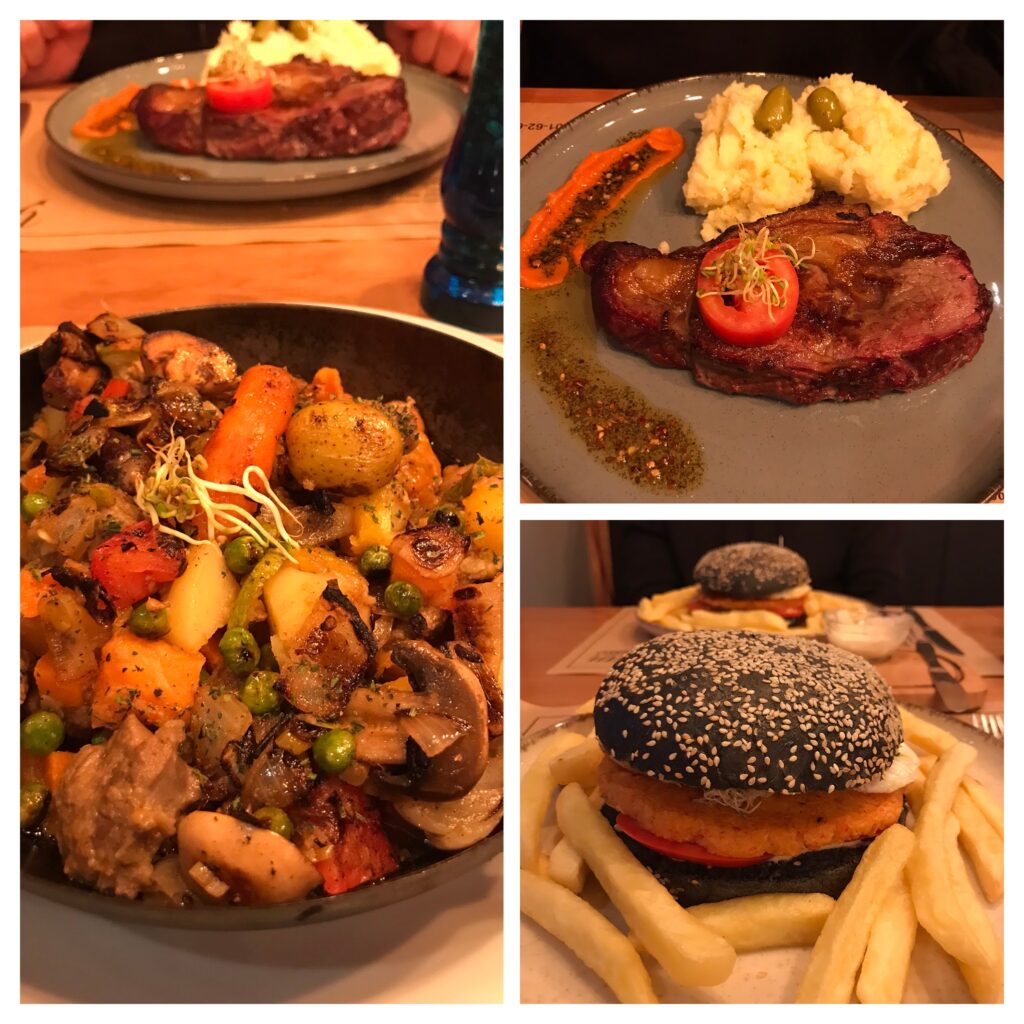
A real-life crabby patty
Ramos Generales El Almacén – nice meal but a bit on the expensive side, I had the rabbit burger.
Hard Rock Cafe Ushuaia – we spent an afternoon drinking beer here and people watching, it’s not our usual haunt but we needed to kill some time before catching our flight.
Activities
Museo Marítimo y del Presidio de Ushuaia – part prison museum and part maritime museum, this has something for everyone. I particularly enjoyed learning about the evolution of the prison colony in Ushuaia, the prisoners’ stories and daily routines. You actually get to visit the cells and experience the cold, harsh conditions in the prison. There’s also information about polar expeditions and the Falklands war that is fascinating. If you run out of time like us, you can re-use your ticket to gain entry the next day, you just need to make sure you get the ticket stamped before you leave.
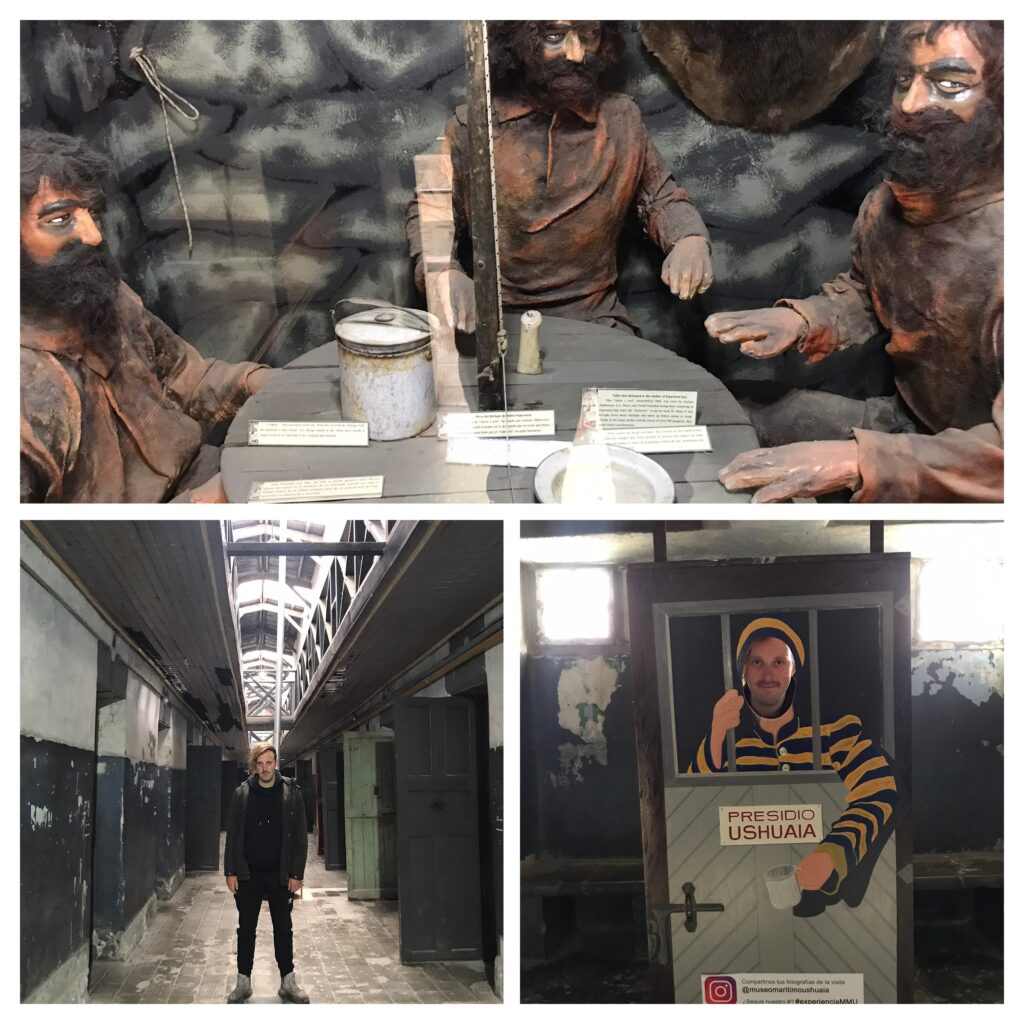
Half day boat trip around Beagle Channel with Info de Ushuaia – this encompassed Islas de los Pájaros, Islas de los Lobos and Les Eclaireurs Lighthouse – we were lucky enough to see humpback whales on this trip alongside sea lions and Magellenic penguins. We also caught a glimpse of Puerto Williams across the water in Chile. It’s important to note that it was VERY cold on the boat trip with biting wind in late March, I recommend wearing thermals and cold weather clothing. You need to board the boat at the Tourist Port, to get the best seats on the boat you need to arrive early otherwise you won’t get a window seat.
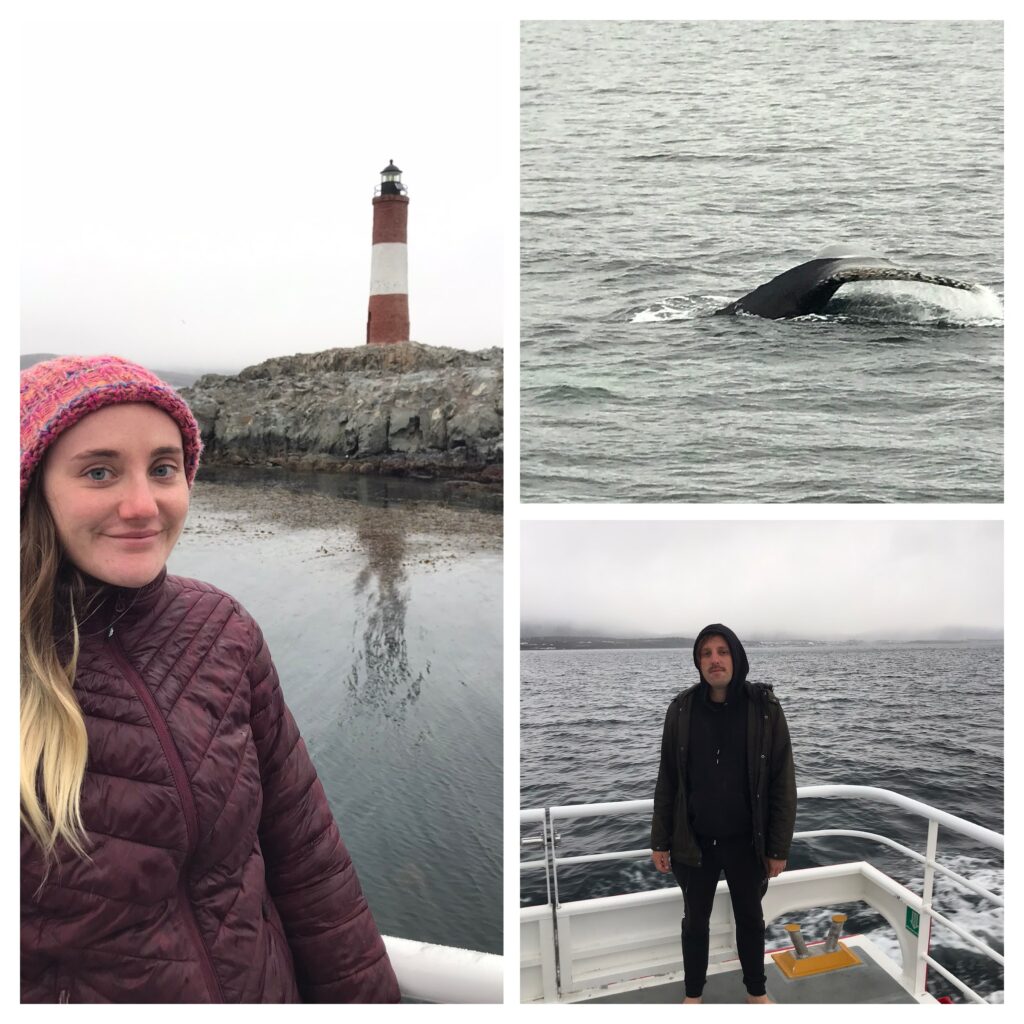
Don’t be like Dan and insist on wearing no shoes outside because his socks were wet – it’s freezing!
Half day Tierra del Fuego National Park tour with Info de Ushuaia – this tour included tickets for the End of the World Train too. This park contains the famous ‘end of the world’ sign at the end of the Pan-American highway, as well as the world’s most southerly post office. We really enjoyed visiting the national park especially with fresh snow, learning about the wild horses abandoned by their owners and marvelling at the landscape from the comfort of the train. The railway was built by prisoners from the Ushuaia prison colony for use by other prisoners who would venture out to chop wood in the surrounding forests. You can still see the stubs of the trees cut by prisoners. There’s an audio guide in multiple languages available on the train journey, this provides helpful explanations about the railway and its use by prisoners.
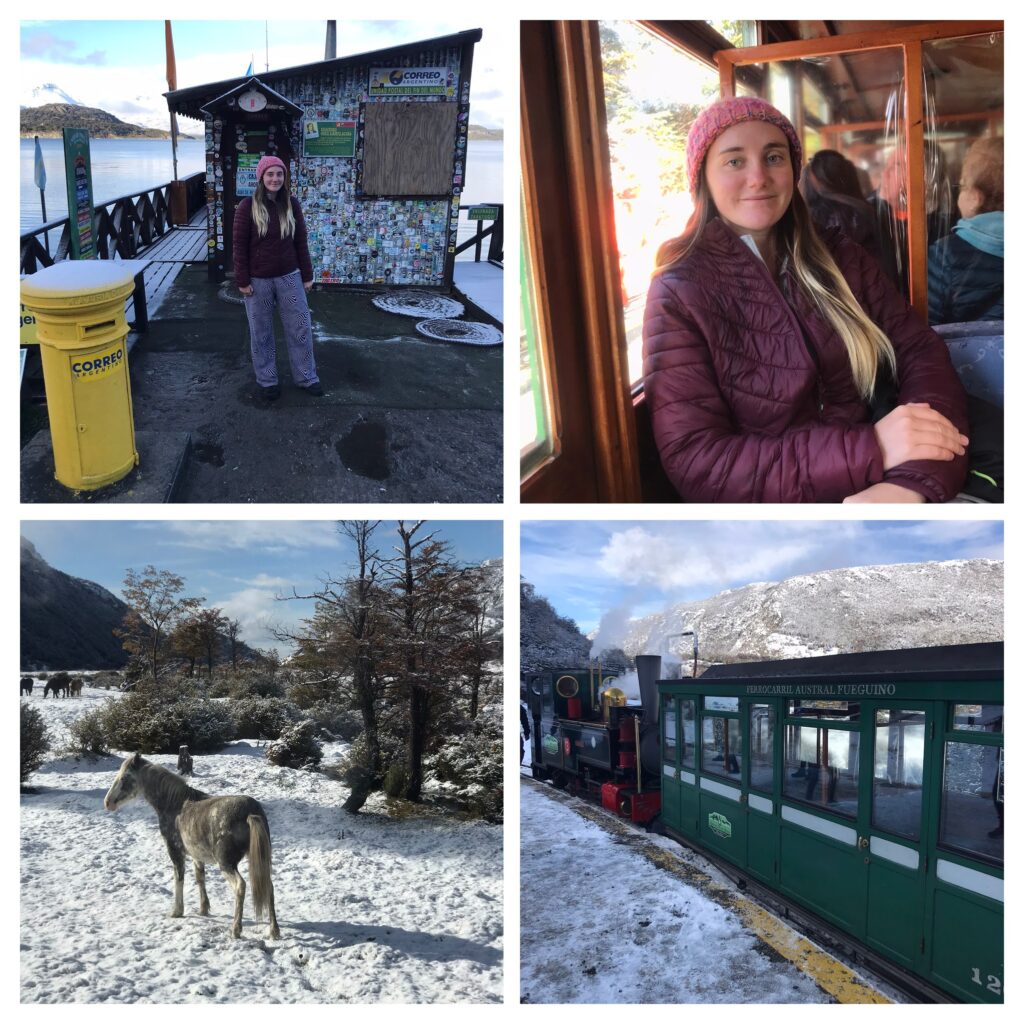
A trip to Ushuaia isn’t complete without visiting the post office in Tierra Del Fuego and riding the ‘end of the world’ train
Tourist Information Centre near the Tourist Port – here you can stamp your passport with the iconic Ushuaia stamp, if you so wish. There’s also free wifi too!
We took a flight out of Ushuaia to Buenos Aires with FlyBondi.
Buenos Aires
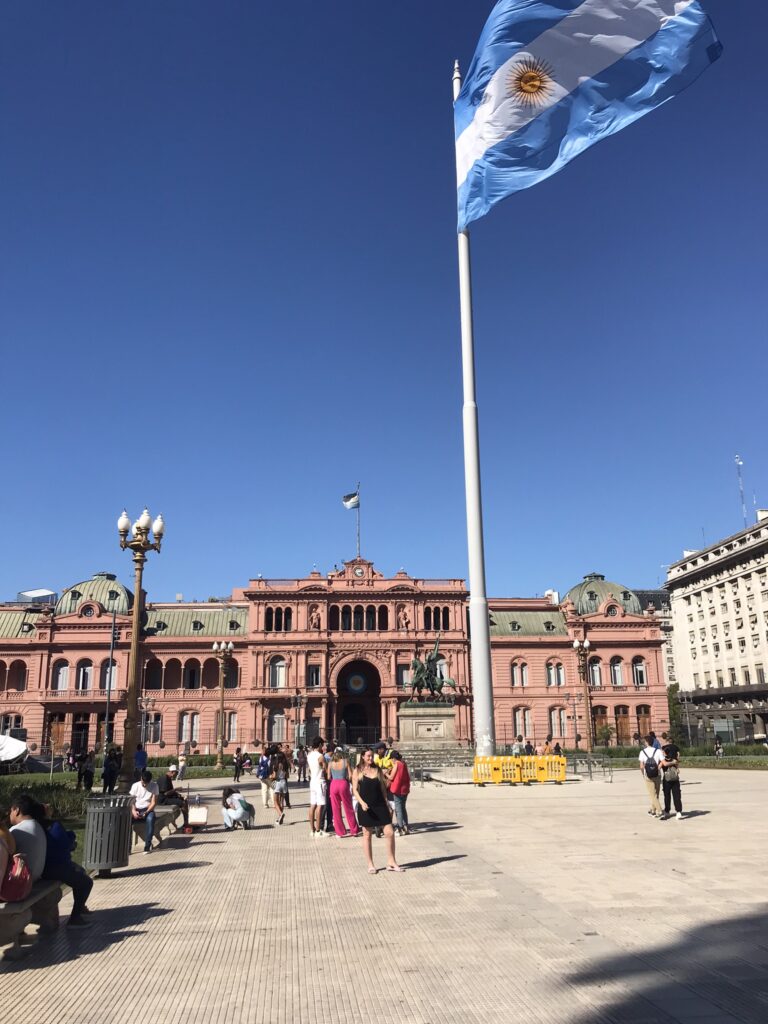
Argentina’s capital and the home of tango. Buenos Aires is a huge city with a thriving centre and many unique neighbourhoods to explore. We stayed in both Palermo and the city centre, sandwiching a short trip to Uruguay which is easily accessible by boat from Buenos Aires.
Accommodation
Airbnb in Palermo – we loved this area as there were loads of restaurants and nice places to eat without it being too loud at night and it was far away enough from the centre that we didn’t see many tourists, it was just an affluent suburb for local residents. When we returned from Uruguay we wanted to stay in the same area but everything was booked up sadly.
Grand King Hotel – we booked this last minute as it was the cheapest place we could find in the centre, the hotel was okay but felt more 3 stars than its advertised 4 star rating. This hotel seems to view itself as high-brow and the door staff were initially a bit wary of us as we turned up with big backpacks looking a little forlorn. The Grand King is located close to the main pedestrian areas of Florida y Lavalle and is within walking distance of the Recoleta and San Telmo neighbourhoods.
Foodie Places
Chori – various different offerings of choripan, I cannot recommend this place enough, we ate here twice in two days and in my opinion it is hands down the best place to try choripan in Buenos Aires.
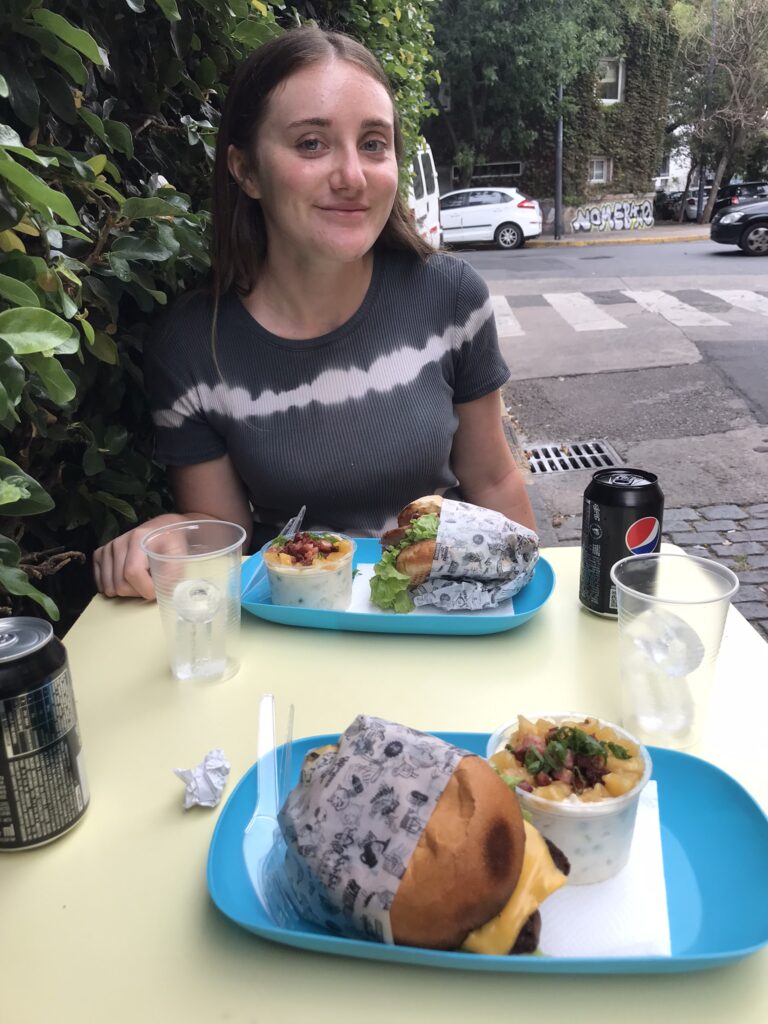
Chori has Choripan to die for!
Kotten Sushi – great sushi
Santos Pizza – located in the centre of Buenos Aires, we absolutely loved this place! We even spoke to the owner to say how much we liked it. The pizzas were authentic and cheap and the staff were also very generous when I wanted to try fernet and coke, I almost got a 50:50 ratio of each and they only charged me for one shot!
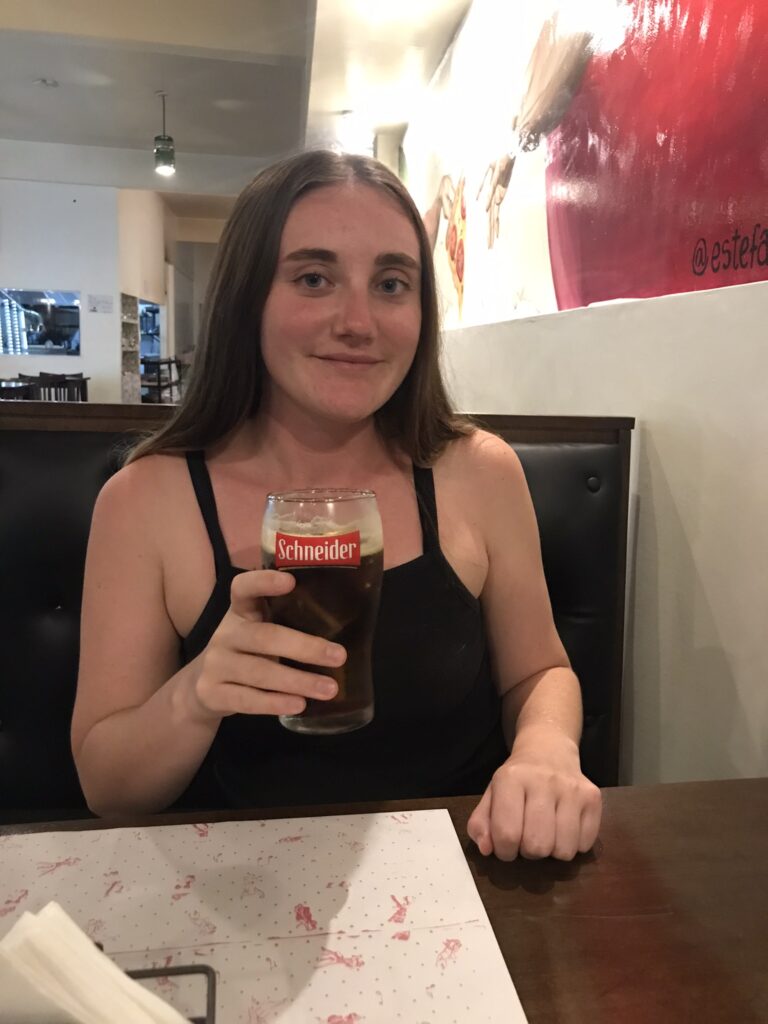
Our first and only taste of fernet – Argentinians are crazy about it
Mercado San Telmo – I was super excited to go to this food market in San Telmo but once we arrived I realized it wasn’t for me, it was ridiculously busy, there were no any seats at any of the food vendors and people were packed in like sardines. We walked in and pretty much walked straight out. I’m not sure if we hit it at peak time or if it was a holiday or weekend but I would definitely recommend avoiding at any potentially busy times. It was a hellish scene that I don’t want to repeat.
I want to preface this next section with the fact that I really loved the tango shows in Buenos Aires. The musicians were excellent, the crooners magical and the dancers exotic and intimate. However we did have some mixed experiences with the shows that I feel obliged to share.
So this is my opinion on tango shows – I felt that the tango shows were specifically aimed at milking money from tourists. We attended two tango shows at very different venues (one larger at Tango Porteno and one more intimate at El Querendi), however at both tango venues it felt like a well-oiled money-making machine. For example, at El Querandi there are two prices listed on the website – one for tourists and one for Argentinians with the tourist price almost double the price for Argentinians. I usually find this distasteful as a backpacker, I have a very tight budget and don’t like paying more money for the same overall experience i.e. eating the same food or drinking the same wine. I found this practice of overcharging tourists quite common in South America but I still didn’t like it, I fully support discounted prices for national parks and museums for nationals, but not food and wine. At El Querandi, I’m not sure if this was deliberate or not but after booking a package that included wine and a meal, we were given a wine menu and not offered our included bottle of wine. I felt like this was done purposely so that we’d order an extra bottle of wine instead of awkwardly requesting the bottle that was included in the price. There is also a photographer that takes photos of the audience, these photos were then printed and at the very end we felt there was pressure to buy these photos and I had to resort to handing the photographer the printed out photos and saying that I didn’t want them, this made the evening more awkward and uncomfortable than necessary. I was just there to drink wine and watch tango!
Tango shows: do’s and don’ts
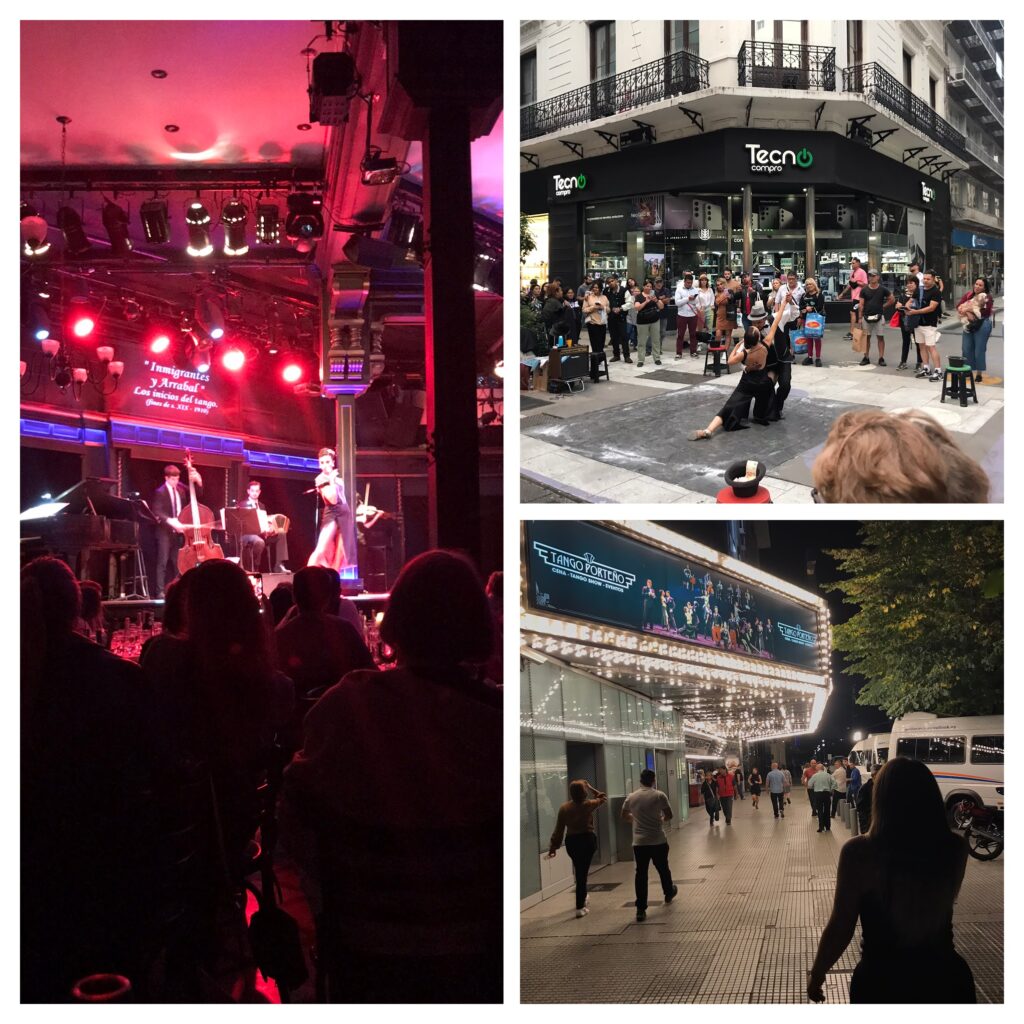
In my opinion, watching a live tango show in Buenos Aires is a must – we watched two stage productions as well as numerous street performances in our short time there. However there are a few things I wish I’d known beforehand in order to make the experience a little smoother. Read my blog post on tango do’s and don’ts based on my own personal experiences here!
Activities
Free walking tour of the city centre booked with Guruwalk, this included all the main sites.
El Querandi – Cena Tango Show – mixed feelings about this tango venue, I really loved the show though, it was an intimate performance with a small audience. The musicians, dancers and singers were all fantastic.
Tango Porteño – a much bigger venue, more like a theater. We were seated towards the back so our view of the stage and performance wasn’t as good as at El Querandi. Again excellent musicians, singers and dancers.
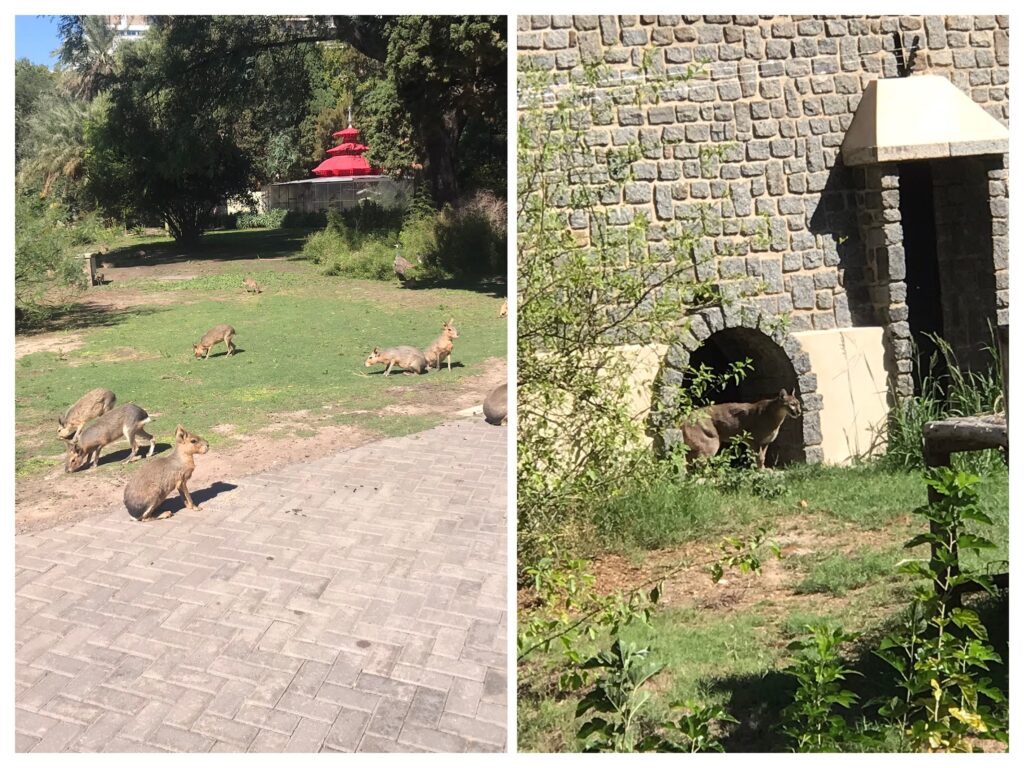
A puma in Buenos Aires! In the ecoparque sadly but the cat seemed happy enough
Buenos Aires Ecoparque – free entry! We were surprised by the amount of Patagonian mara hopping about in the park, fascinating and strange little creatures. We also saw a tapir, elephants, rhea, buffalos and a puma. Overall a good, cheap attraction.
Jardín Japonés – You have to pay an entrance fee to enter this little slice of calm. An oasis in the centre of the hussle and bustle of Buenos Aires, the Japanese influence is visible in the garden design and it is maintained by the Japanese community.
Museo Evita – I found this museum really interesting as I had very limited knowledge of who Evita was, her legacy lives on in minds and hearts of the people in Argentina.
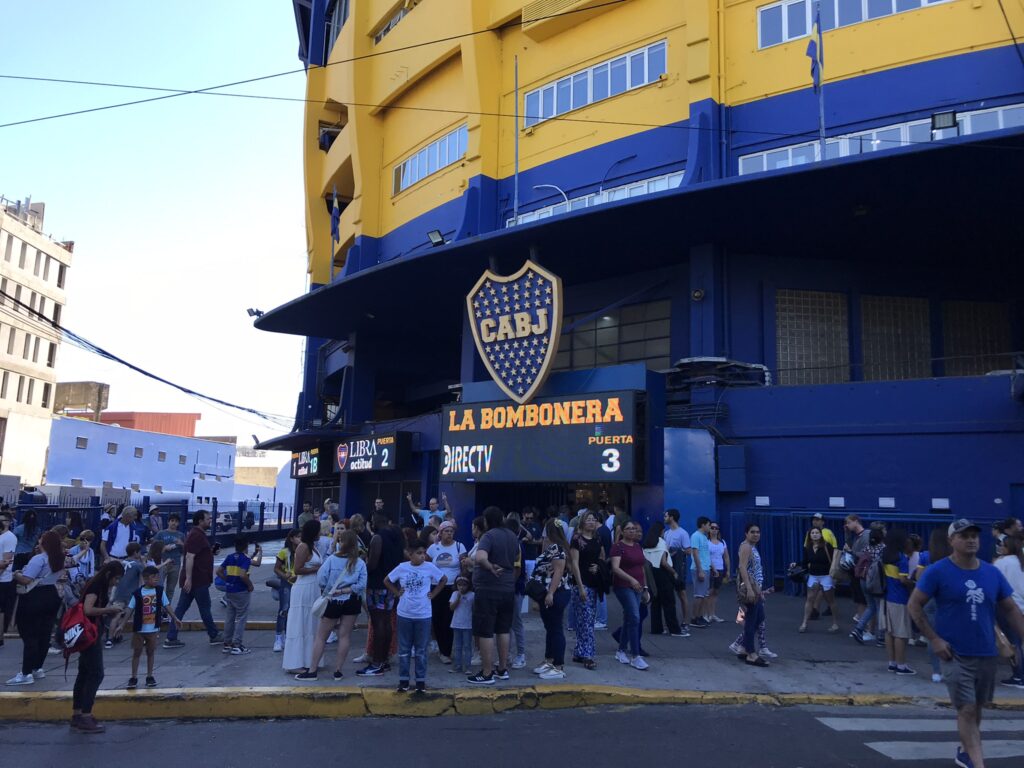
Boca neighbourhood self-guided tour with GPSMyCity including Boca Juniors stadium – I’m not a football fan but when in Rome… We admired the outside of the stadium and all the locals in their blue and yellow football shirts.
Recoleta Cemetery – we opted not go inside as we found out you have to pay for admission, by this point we’d already visited many grand Latin American cemeteries including Punta Arenas and Havana so didn’t want to pay to see more of the same.
Museo Nacional de Bellas Artes – free entry! Definitely worth a visit on a rainy day.
Puerto Iguazu
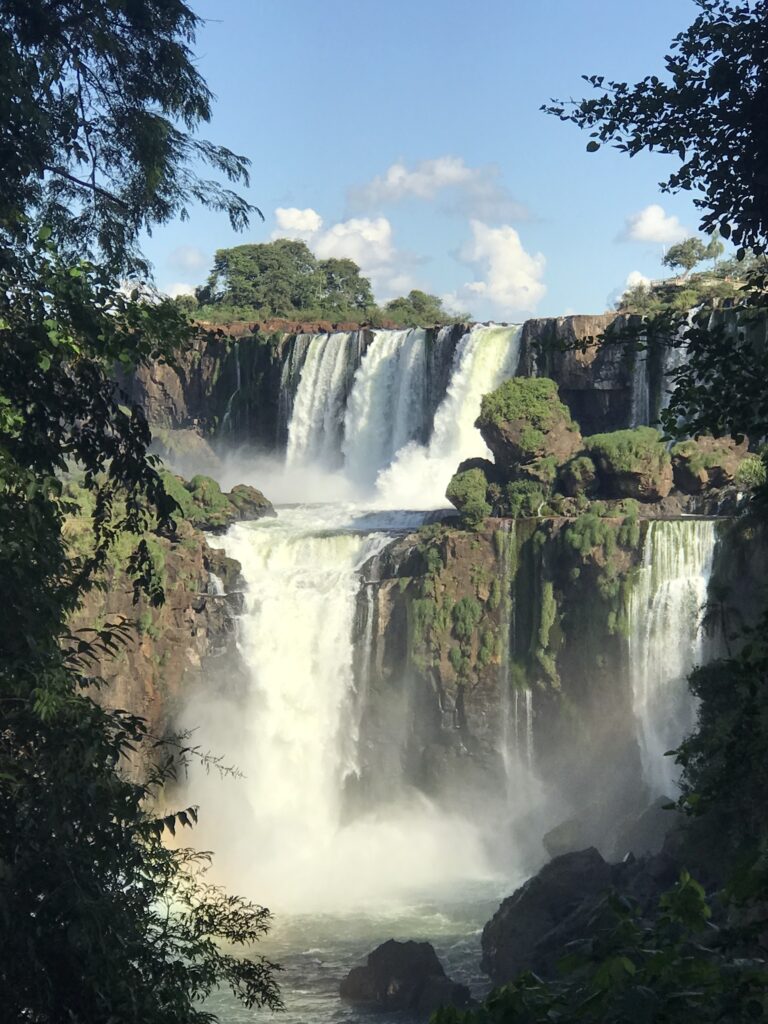
We flew into Puerto Iguazu from Buenos Aires. Hot, humid and jungle-like, Puerto Iguazu sits on a tri-border area with Foz do Igacu (Brazil) and Ciudad del Este (Paraguay). Puerto Iguazu is the place to stay if you want to see Iguazu Falls from the Argentinian side, however it is also possible to get transport from here to the Brazilian side of the falls. Make sure to use Flybondi if you book national flights in Argentina, Flybondi is a budget airline that allows you to pay for flights in cash. This allows you to make the most of the blue dollar system.
Accommodation
Arapy Bed and Dream – I highly recommend this place, it was cheap, clean, it had a swimming pool and the owner was a lovely lady with Ukrainian heritage who was super friendly and helpful.
Foodie Places
Venancio Parrilla Restaurant -we enjoyed a lovely meal of parilla (bbq’d meats) here
Aqva Restaurante Iguazú – a little on the expensive side however a nice treat if you want to indulge in fine-dining with friends like we did.
Activities
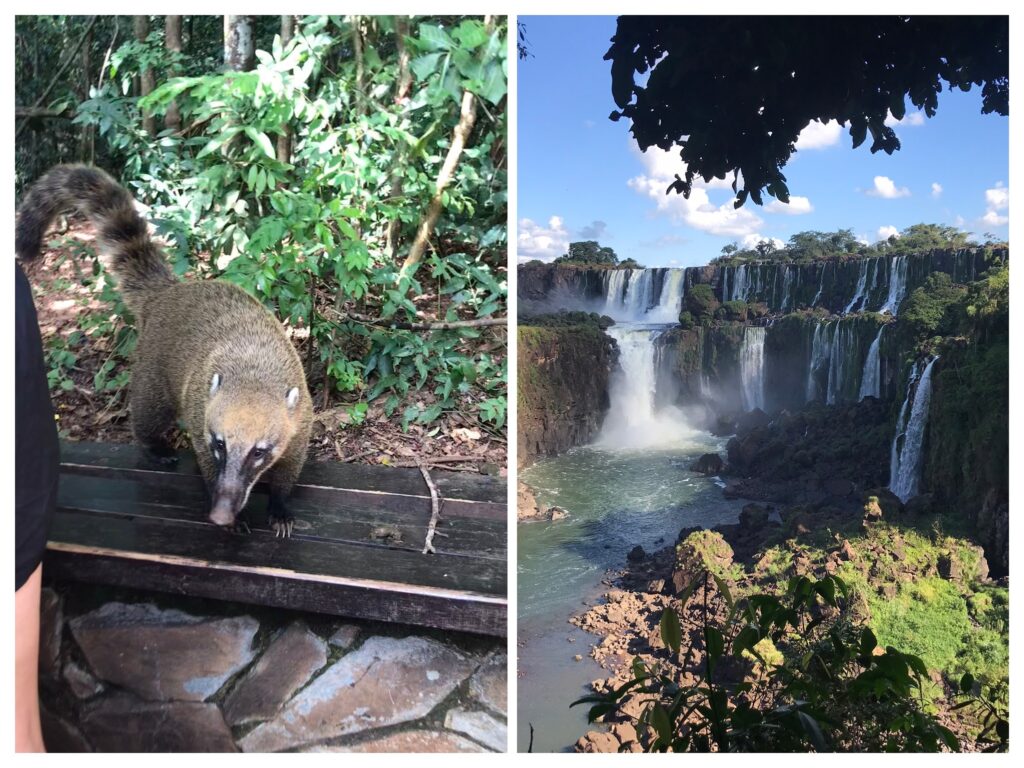
Iguazu Falls – just head to the bus station in Puerto Iguazu and look for a sign that says ‘Cataratas’ (Spanish for waterfall), just make sure you don’t get a ticket to the Brazilian side if you actually want the Argentinian side. I recommend pre-booking a ticket for the park, entry is in timeslots and when we arrived and bought our tickets we had to wait around for 30 minutes before our timeslot to enter the park. We then had to wait again for the free train to the waterfalls, overall a lot of time spent waiting around before we were able to see anything. The devil’s throat trail is the most popular so be prepared for crowds and people pushing to the front for a picture, also be prepared to get wet from the spray of the waterfall. As well as the devil’s throat there are other trails you can hike to get a different view of the falls, we completed the inferior and superior circuit too.
As well as the waterfalls, in the park you will see a variety of wildlife including coati, these are long-nosed mammals with a stripey, bushy tail. Park rangers consider them pests as they try to steal food from tourists and they scratch overly friendly visitors who get too close. We loved watching them trying to steal food, very sneaky animals! Keep an eye out for monkeys on the Superior and Inferior trail too, we spotted the monkeys up close and it was an unforgettable experience.
